 If you want a prime example of the problems that befell the majority of the Millennium series of Godzilla films, you need look no further than this second entry, which is technically the first Godzilla movie of the 21st century since Godzilla 2000 was actually released in Japan in 1999. In fact, it seems like the number two has always been a major stumbling block for the people at Toho since every second entry in each cycle of films has ended up being one of the weakest entries in the franchise as a whole. Let's take a quick look back: you had Godzilla Raids Again, which was a very by-the-numbers monster movie with lackluster characters, huge chunks of the film where nothing interesting was going on, and was a major step-down from the immortal classic that is the original Godzilla; Godzilla vs. Biollante was an attempt by a brash, young upstart to completely refurnish the series to conform to his own feelings about how it should go in order to stay relevant in a new generation that ultimately resulted in an overblown, plodding, and pretentiously self-important film that is so needlessly complex in its dealing with international politics and other issues that it's absolutely ridiculous; and then, we have this film, Godzilla vs. Megaguirus, which isn't even a sequel to Godzilla 2000 but, regardless, not only makes the same mistakes as that film but also makes some serious ones of its own. Like its predecessor, it revels in the time-worn formula and old-fashioned effects of this series, the latter of which fare even worse here than they did in the previous film, but it also gives us a cast of characters that are very bland in addition to being archetypal (which makes them very hard to care for), an antagonistic monster who's more of a nuisance to the humans' plans to get rid of Godzilla than an actual threat, and, worst of all, a characterization of Godzilla as just a typical, faceless, rampaging monster. With all of this and more going against it, it's small wonder that the film bombed badly when it was released in December of 2000.
If you want a prime example of the problems that befell the majority of the Millennium series of Godzilla films, you need look no further than this second entry, which is technically the first Godzilla movie of the 21st century since Godzilla 2000 was actually released in Japan in 1999. In fact, it seems like the number two has always been a major stumbling block for the people at Toho since every second entry in each cycle of films has ended up being one of the weakest entries in the franchise as a whole. Let's take a quick look back: you had Godzilla Raids Again, which was a very by-the-numbers monster movie with lackluster characters, huge chunks of the film where nothing interesting was going on, and was a major step-down from the immortal classic that is the original Godzilla; Godzilla vs. Biollante was an attempt by a brash, young upstart to completely refurnish the series to conform to his own feelings about how it should go in order to stay relevant in a new generation that ultimately resulted in an overblown, plodding, and pretentiously self-important film that is so needlessly complex in its dealing with international politics and other issues that it's absolutely ridiculous; and then, we have this film, Godzilla vs. Megaguirus, which isn't even a sequel to Godzilla 2000 but, regardless, not only makes the same mistakes as that film but also makes some serious ones of its own. Like its predecessor, it revels in the time-worn formula and old-fashioned effects of this series, the latter of which fare even worse here than they did in the previous film, but it also gives us a cast of characters that are very bland in addition to being archetypal (which makes them very hard to care for), an antagonistic monster who's more of a nuisance to the humans' plans to get rid of Godzilla than an actual threat, and, worst of all, a characterization of Godzilla as just a typical, faceless, rampaging monster. With all of this and more going against it, it's small wonder that the film bombed badly when it was released in December of 2000. I know I wasn't too impressed with it when I first saw it, which was when I was 17 years old. Although this and the rest of the Millennium films didn't make it to America until around 2004-2005, I knew of them thanks to someone who was as much, or perhaps even more (if that's possible), of a Godzilla fan than I was and showed some pictures on the internet of both this film and the later one, Godzilla Against Mechagodzilla. However, this was during another one of those periods where I had kind of moved beyond Godzilla and so, I wasn't exactly waiting around and anxiously anticipating their American releases. In fact, I didn't even know they had come to America until I just stumbled across the DVDs of some of them at an FYE one day. I actually didn't buy any of them until I went to a now defunct chain called Media Play, saw some copies of this film and the next one, Godzilla, Mothra, and King Ghidorah: Giant Monsters All-Out Attack, and decided, "Why not?" However, I came to kind of regret that decision when I watched Godzilla vs. Megaguirus the following Saturday. Not only did I have something of a snobby attitude towards these movies in general at that point thanks to what I had learned about film technique and criticism but, furthermore, I couldn't believe how amateurish and poorly made it was for something from the year 2000, not to mention that it was a studio movie. The effects in the old films may have looked primitive by this point but this movie wasn't even five years old when I first saw it and yet, it was amazing how archaic the stuff in it looked. What's more, there are editing effects in this film that look like something you'd expect to see on a cheap, direct-to-video movie or, for that matter, a Sci-Fi Channel original, not a fairly-sized, theatrical film released by a studio like Toho in the year 2000. My thoughts were, "My God, is this really the best they can do after all this time and experience?" Putting aside the fact that the Japanese film industry doesn't have the money or the access to equipment and technology that Hollywood does, this film movie was just plain bad... which it still is. I may have matured considerably since then and have come to respect and defend the techniques used to make these movies but, there's little here than I can defend. It's an okay way to kill 105 minutes and has some decently entertaining monster sequences. Those are the only compliments I can give it. Otherwise, I agree with Ben Wagner's of Toho Kingdom three-word assessment of it: "Run-of-the-mill, mediocre, and sterile."
In 1954, Godzilla raids Tokyo for the first time and mankind is powerless to do anything to stop him. After he finishes laying waste to the city and returns to the sea, the capital of Japan is moved to Osaka and the country slowly gets back on its feet. But, Godzilla returns twelve years later in 1966 and attacks Japan's first nuclear plant in Tokai. In order to keep the monster from attacking further, the government decides to prohibit the use of nuclear energy and come up with safer and cleaner types of energy, eventually leading them to the creation of plasma energy. However, this doesn't deter Godzilla from attacking either and he returns to raid Osaka in 1996 for the plasma energy reactor there. During his attack, a military bazooka squad attempts to stop him but, not only do they fail, their commanding officer is killed in the battle when he saves soldier Kiriko Tsujimori from being killed. Five years later, Tsujimori is now the head of a division of the Japanese Self-Defense Force called the G-Graspers, whose duty is to monitor Godzilla and protect Japan from any further attacks, a duty that she takes to heart due to what happened to her commanding officer. The government is currently developing a satellite device called Dimension Tide that will fire a miniature black-hole and, hopefully, swallow Godzilla up. They enlist a young electronics and physics expert, Hajime Kudo, to help them in getting the black-hole down to the workable size of two meters. Three months later, Dimension Tide is put through its first test but, while it does work, it opens up an inter-dimensional wormhole in the process. A young boy, who was earlier caught watching the test and is asked to keep it a secret, discovers that a prehistoric type of dragonfly has come through the wormhole from the prehistoric past and has left behind a large, moist egg. The kid, Jun, who is an insect enthusiast, takes it with him when he and his parents move to Tokyo shortly afterward and ultimately disposes of it by dumping it into the sewers. As the G-Graspers continue to develop Dimension Tide , the egg, which is actually made up of hundreds of others, soon produces a swarm of human-sized dragonfly larvae called Meganulons that begin attacking people as well as flooding that district of the city from the damage they cause to the sewer system. Godzilla soon appears off the coast of Japan and the government decides to go ahead and use the newly-launched Dimension Tide satellite, even though it hasn't been fine-tuned yet. Godzilla is eventually lured to an uninhabited island where the attack can be carried out safely but, before they can do so, the dragonflies, which have now molted into full-fledged adults called Meganulas, attack Godzilla in an attempt to collect some of his energy. When Dimension Tide is finally fired, its being less than perfected causes it to miss Godzilla, after which it becomes temporarily useless since it takes an hour for the system to cool down for another shot. Not only does Godzilla escape but the surviving Meganulas retreat back to Tokyo and use the energy they took from Godzilla to energize and awaken their queen: Megaguirus, who soon begins her own rampage and eventually battles Godzilla. However, she may ultimately prove to be an even worse hindrance in the battle against Godzilla... one that could cause Dimension Tide to fail altogether. And also, why is Godzilla heading back to Japan where there's no plasma or nuclear energy to attract him in the first place?
This is the film where the concept of each entry in the Millennium series being its own, stand-alone story in a continuity separate from everything before and after it made itself known not only to the general public but to the filmmakers as well. The original plan was for a trilogy of films that Godzilla 2000 was to have been the first installment of, a trilogy that in itself would have been completely separate in continuity from anything that had gone before, explaining why 2000 makes no mention of the events of the original Godzilla. (I did not fully comprehend this original plan when I wrote my review of the previous film, which is why I questioned the hindsight idea that each of these Millennium films uses the original 1954 film as its jumping-off point.) But, while Godzilla 2000 had done well enough to be the most successful domestic film of the 1999 holiday season, it was hardly a blockbuster, and, in fact, had it not been for the American theatrical release (which itself was not an enormous commercial success), Toho would have lost money on it. Furthermore, while the American release did better than it probably would have otherwise thanks to the lingering bad feelings from the 1998 movie and the novelty of seeing the classic Godzilla on the big screen, it was highly unlikely that this scenario would stick around for further movies in the series. So, knowing that they would more than likely be once again courting a predominant Japanese audience, which in itself could have reacted much better to the first Millennium film, Toho decided that they needed to spend less money on the films and that some creative changes needed to be made. This is what prompted Shogo Tomiyama to throw out his original trilogy idea and decided to make each film its own stand-alone movie. Tomiyama said that each film would represent an opportunity to go in new directions and experiment (hardly, as we'll see down the road) but a simpler and more cynical way to look at it is, since each film ends with the possibility of a follow-up, Toho was just trying to find an approach that would click with audiences. To be even more blunt, they were throwing stuff at the wall in order to find something that would stick. Obviously, since Godzilla vs. Megaguirus ended up doing badly enough to become one of the lowest-grossing Godzilla movies ever, ending up alongside Godzilla vs. Megalon and Terror of Mechagodzilla, this particular approach wasn't it. In fact, its failure was so disparaging that Tomiyama considered throwing in the towel and ending Godzilla altogether.
 Following Takao Okawara's departure from Toho after Godzilla 2000, it was time to find a new director and Tomiyama ultimately chose Masaaki Tezuka, who had mainly served as an assistant director beforehand on films like Koji Hashimoto's Sayonara Jupiter, 47 Ronin, and, most significantly, the latter two Rebirth of Mothra films (David Kalat also credits him as having been an assistant director on Godzilla vs. Mechagodzilla II but I can't confirm this; it wouldn't be the first time he's been wrong about something, though). Godzilla vs. Megaguirus would be his first film as director and apparently, unlike the indifferent Okawara, Tezuka was absolutely thrilled at the chance to helm a Godzilla movie. But, enthusiasm only gets you so far and ultimately, while Megaguirus did come out having some fairly entertaining moments and scenes, particularly the big battle between Godzilla and the antagonistic monster, its lackluster script, run-of-the-mill story and conception, and fairly low budget overwhelmed the first-time director and made it impossible for him to make it anything other than average at best. Plus, I don't think that Tezuka is even that talented of a director to begin with. As I've described, you might chock this film up as simply the end result of factors that he had no control over but Tezuka would return to direct Godzilla Against Mechagodzilla and Godzilla: Tokyo S.O.S. down the line, both of which are just as uncreative and yawn-inducing as Megaguirus. In fact, Tezuka helped right the screenplay for the latter, which is one of the absolute worst, so he has to take much of the blame when it comes to that one. But more on that later.
Following Takao Okawara's departure from Toho after Godzilla 2000, it was time to find a new director and Tomiyama ultimately chose Masaaki Tezuka, who had mainly served as an assistant director beforehand on films like Koji Hashimoto's Sayonara Jupiter, 47 Ronin, and, most significantly, the latter two Rebirth of Mothra films (David Kalat also credits him as having been an assistant director on Godzilla vs. Mechagodzilla II but I can't confirm this; it wouldn't be the first time he's been wrong about something, though). Godzilla vs. Megaguirus would be his first film as director and apparently, unlike the indifferent Okawara, Tezuka was absolutely thrilled at the chance to helm a Godzilla movie. But, enthusiasm only gets you so far and ultimately, while Megaguirus did come out having some fairly entertaining moments and scenes, particularly the big battle between Godzilla and the antagonistic monster, its lackluster script, run-of-the-mill story and conception, and fairly low budget overwhelmed the first-time director and made it impossible for him to make it anything other than average at best. Plus, I don't think that Tezuka is even that talented of a director to begin with. As I've described, you might chock this film up as simply the end result of factors that he had no control over but Tezuka would return to direct Godzilla Against Mechagodzilla and Godzilla: Tokyo S.O.S. down the line, both of which are just as uncreative and yawn-inducing as Megaguirus. In fact, Tezuka helped right the screenplay for the latter, which is one of the absolute worst, so he has to take much of the blame when it comes to that one. But more on that later. Few casts in any of the Godzilla movies are made up of more faceless, archetypal characters than that of Godzilla vs. Megaguirus. I could literally sum up each character and their motivations in just a few words and move on because there's nothing deep about any of them, even in the case of those who should have more to them. David Kalat said it best by describing them as, "ciphers, narrative pawns moved around to keep the monster action going." For instance, our lead, Maj. Kiriko Tsujimori (Misato Tanaka) has only one thing on her mind and that's continuing her late commanding officer's fight against Godzilla in an act of revenge. That really is almost all she ever thinks or talks about, and she's so obsessed with killing Godzilla that she motions for Dimension Tide to be used even before it's completely ready and when it doesn't work, she acts like a bitch and blames the lead guy for its failure. You may get why she wants Godzilla dead so badly, which also has to do with her not wanting the new generation of Japan to live in fear, but it's like, "Lady, chill out." When she's not doing that, she spends the rest of the time being the typical tough, military woman whom no one, including the lead guy, can get close to. They also try to make you feel for her by making it look like she's going to sacrifice herself in order to kill Godzilla by having Dimension Tide lock onto her ship right above the monster, as well as cheer for her when, just before that, she slugs the guy who's responsible for Godzilla's attack and all the people he's killed, but she's so one-dimensional and clichéd that it's nigh impossible to give a crap. If you want a much more interesting and well-developed character with a personal grudge against Godzilla, check out Maj. Yuki in Godzilla vs. SpaceGodzilla (speaking of which, I doubt the presence of a similar type of character here is coincidence given how one of the writers also wrote SpaceGodzilla).
Few casts in any of the Godzilla movies are made up of more faceless, archetypal characters than that of Godzilla vs. Megaguirus. I could literally sum up each character and their motivations in just a few words and move on because there's nothing deep about any of them, even in the case of those who should have more to them. David Kalat said it best by describing them as, "ciphers, narrative pawns moved around to keep the monster action going." For instance, our lead, Maj. Kiriko Tsujimori (Misato Tanaka) has only one thing on her mind and that's continuing her late commanding officer's fight against Godzilla in an act of revenge. That really is almost all she ever thinks or talks about, and she's so obsessed with killing Godzilla that she motions for Dimension Tide to be used even before it's completely ready and when it doesn't work, she acts like a bitch and blames the lead guy for its failure. You may get why she wants Godzilla dead so badly, which also has to do with her not wanting the new generation of Japan to live in fear, but it's like, "Lady, chill out." When she's not doing that, she spends the rest of the time being the typical tough, military woman whom no one, including the lead guy, can get close to. They also try to make you feel for her by making it look like she's going to sacrifice herself in order to kill Godzilla by having Dimension Tide lock onto her ship right above the monster, as well as cheer for her when, just before that, she slugs the guy who's responsible for Godzilla's attack and all the people he's killed, but she's so one-dimensional and clichéd that it's nigh impossible to give a crap. If you want a much more interesting and well-developed character with a personal grudge against Godzilla, check out Maj. Yuki in Godzilla vs. SpaceGodzilla (speaking of which, I doubt the presence of a similar type of character here is coincidence given how one of the writers also wrote SpaceGodzilla).  Gee, I wonder who the human bad guy is going to be? That was my thought the minute I saw Sugiura (Masato Ibu), the government secretary who is basically the one in charge of the G-Graspers. And, what do you know, I was right! Even though the guy doesn't start to reveal his true, underhanded nature until the film's second half, and is, in fact, promoting clean energy when you meet him during the prologue, you just look at him and you smell a rat. At first, you're supposed to think that he's simply intent on destroying Godzilla for the sake of the country and that that's why he tells those behind Dimension Tide that they'd best get their weapon ready as soon as possible, as well as why during the actual battles against the monster, he becomes frantic when things go awry and starts acting like a complete jackass to those at the controls. But, even before that first battle with Godzilla, it becomes clear that Sugiura isn't the most sympathetic or trustworthy person when, after Kudo and Dr. Yoshizawa berate him and Tsujimori for getting the government officials to approve Dimension Tide even though it's not quite ready yet, he just waves them off with a cheesy, fake smile and walks away! And it's outright confirmed that's something up when, after the failed attack on Godzilla, we get a scene where Sugiura is seen telling someone on the phone (possibly the prime minister) that he's sure that Godzilla will head for Tokyo and attack "National Institute of Chemistry" in the Shibuya District. Why? That's what the other characters try to find out but Sugiura, again, simply blows off their questions and doesn't give them an answer. It's only when he flies out to the battle site after Godzilla has arrived in Tokyo and is heading for the institute that Sugiura is forced to reveal that the institute has continued experimenting with plasma energy, despite the banning of such energy after Godzilla's attack on Osaka in 1996, and that there's a reactor there. He at first insists that it was done for the benefit of mankind but doesn't deny that, as Yoshizawa suggests, it would also mean a big promotion for him. This is enough to make Tsujimori deck Sugiura right in the face, especially after he tries to blame the G-Graspers for what's happened, and he's never seen again after that, although we hear during the epilogue that there's going to be an inquiry over why plasma research was carried out after the ban and the Sugiura is going to be a chief witness there. In other words, it doesn't sound like he's going to be punished for his role in getting a bunch of people killed, which is about how it goes with politicians, isn't it? There's nothing else to say about the guy. He's hardly an original human antagonist in concept, rouses your suspicions as soon as you see him, and is nowhere near as interesting or developed as the corrupt businessmen and developers we've dealt with in the past.
Gee, I wonder who the human bad guy is going to be? That was my thought the minute I saw Sugiura (Masato Ibu), the government secretary who is basically the one in charge of the G-Graspers. And, what do you know, I was right! Even though the guy doesn't start to reveal his true, underhanded nature until the film's second half, and is, in fact, promoting clean energy when you meet him during the prologue, you just look at him and you smell a rat. At first, you're supposed to think that he's simply intent on destroying Godzilla for the sake of the country and that that's why he tells those behind Dimension Tide that they'd best get their weapon ready as soon as possible, as well as why during the actual battles against the monster, he becomes frantic when things go awry and starts acting like a complete jackass to those at the controls. But, even before that first battle with Godzilla, it becomes clear that Sugiura isn't the most sympathetic or trustworthy person when, after Kudo and Dr. Yoshizawa berate him and Tsujimori for getting the government officials to approve Dimension Tide even though it's not quite ready yet, he just waves them off with a cheesy, fake smile and walks away! And it's outright confirmed that's something up when, after the failed attack on Godzilla, we get a scene where Sugiura is seen telling someone on the phone (possibly the prime minister) that he's sure that Godzilla will head for Tokyo and attack "National Institute of Chemistry" in the Shibuya District. Why? That's what the other characters try to find out but Sugiura, again, simply blows off their questions and doesn't give them an answer. It's only when he flies out to the battle site after Godzilla has arrived in Tokyo and is heading for the institute that Sugiura is forced to reveal that the institute has continued experimenting with plasma energy, despite the banning of such energy after Godzilla's attack on Osaka in 1996, and that there's a reactor there. He at first insists that it was done for the benefit of mankind but doesn't deny that, as Yoshizawa suggests, it would also mean a big promotion for him. This is enough to make Tsujimori deck Sugiura right in the face, especially after he tries to blame the G-Graspers for what's happened, and he's never seen again after that, although we hear during the epilogue that there's going to be an inquiry over why plasma research was carried out after the ban and the Sugiura is going to be a chief witness there. In other words, it doesn't sound like he's going to be punished for his role in getting a bunch of people killed, which is about how it goes with politicians, isn't it? There's nothing else to say about the guy. He's hardly an original human antagonist in concept, rouses your suspicions as soon as you see him, and is nowhere near as interesting or developed as the corrupt businessmen and developers we've dealt with in the past.  Dr. Yoshizawa is played by a blast from the series' past: the lovely Yuriko Hoshi, who'd starred in both Mothra vs. Godzilla and Ghidorah, the Three-Headed Monster. Unfortunately, the character they give her to play isn't one that she can do much with. As the head scientist behind the Dimension Tide project, Yoshizawa's reasons for wanting Godzilla dead are the same as Tsujimori's: during his 1996 attack on Osaka, he killed some colleagues of hers. We don't learn anything else about these people other than they were close friends with and that their deaths were enough to convince Yoshizawa that Godzilla needed to be destroyed no matter what, as was her desire for this to not happen to anyone else. She also has a past relationship with Kudo in that she was once his college physics professor, which suggests that she may have been the one to see Tsujimori to bring him her since she knows what a smart guy he is. And, like Kudo, that basically sums up her character. Otherwise, all she does is act as the wise voice of reason when people are becoming frantic or getting into squabbles over the situation, as well as suspect that Sugiura isn't telling them all that he knows and, when he finally reveals it, suggest that the secret plasma energy research would mean a big raise for him as well as be a benefit for Japan some day. Sadly, it seems like they brought her back solely for the gimmick of having a recognizable face from the series' heyday here, much like they had done with Akira Takarada in Godzilla and Mothra: The Battle for Earth.
Dr. Yoshizawa is played by a blast from the series' past: the lovely Yuriko Hoshi, who'd starred in both Mothra vs. Godzilla and Ghidorah, the Three-Headed Monster. Unfortunately, the character they give her to play isn't one that she can do much with. As the head scientist behind the Dimension Tide project, Yoshizawa's reasons for wanting Godzilla dead are the same as Tsujimori's: during his 1996 attack on Osaka, he killed some colleagues of hers. We don't learn anything else about these people other than they were close friends with and that their deaths were enough to convince Yoshizawa that Godzilla needed to be destroyed no matter what, as was her desire for this to not happen to anyone else. She also has a past relationship with Kudo in that she was once his college physics professor, which suggests that she may have been the one to see Tsujimori to bring him her since she knows what a smart guy he is. And, like Kudo, that basically sums up her character. Otherwise, all she does is act as the wise voice of reason when people are becoming frantic or getting into squabbles over the situation, as well as suspect that Sugiura isn't telling them all that he knows and, when he finally reveals it, suggest that the secret plasma energy research would mean a big raise for him as well as be a benefit for Japan some day. Sadly, it seems like they brought her back solely for the gimmick of having a recognizable face from the series' heyday here, much like they had done with Akira Takarada in Godzilla and Mothra: The Battle for Earth.  Well, that's the main cast of players but there are many other ancillary characters that are of such little consequence that they either barely say anything or aren't even named at all. For instance, there are only four other members of the G-Grasper team: Hosono (Makiya Yamaguchi), who acts as the main pilot of their special combat aircraft, the Griffon (that sounds familiar, doesn't it?); Mima (Mansaku Ikeuchi), who acts as the team's electronics expert and radar operator; Niikura (Masanobu Katsumura), the information officer; and Okumura (Tetsuo Yamashita), who was a captain in the bazooka squad that Tsujimori was part of (the Rangers) and, as a result, is the only other member who has some meat to him since he understands why she's so obsessed with killing Godzilla. If you're dismayed by the lack of images and think you'll find it hard to remember who these guys are, don't worry about it because they're so superfluous to what goes on that they might as well not exist. You also have that little boy, Jun, (I think his real name is Hiroyuki Suzuki) who not only spies on the first test of Dimension Tide in a field out near his house but is also the one who inadvertently puts Tokyo in danger because he's the one who finds the Megaguirus egg, takes it with him when he and his family move to the city, and ultimately dumps it in the sewer when he decides he doesn't want it anymore. You could say that makes him an important character but that's where his significance ends. He does tell Tsujimori what he did but she tells him that it's not his fault (um, yeah it is) and that they were the ones responsible (kind of, but he still brought the damn egg to Tokyo), letting him off the hook easily. Again, you'd expect him to go on to be in most of the movie given what he does, as well as since he's an insect enthusiast and is able to identify one of the hatched creatures that he saw flying above the city at one point, and also forms something of a bond with Tsujimori, but he virtually disappears from the story after that. Other than a moment where you see him and his mother evacuating when Godzilla is approaching Tokyo during the climax, he only appears again during a scene after the ending credits where he finds out that Godzilla survived being swallowed up by Dimension Tide. We don't get to know Tsujimori's late commanding officer, Miyagawa (Toshiyuki Nagashima) very well since he gets killed in the film's opening but he does manage to come across as strong, confident, and selfless, and you get just enough to understand why Tsujimori would want to continue the fight against Godzilla for him (although, the words of wisdom he once said about fighting something you're afraid of, which she tells to Jun, are a bit corny). There's also the typical scientist character who knows everything about the dragonflies and their nature, even though they've been extinct for millions of years, and is able to make the defense forces understand what they're dealing with. And finally, our old friend Koichi Ueda is here again in one scene as a government official during Tsujimori and Sugiura's meeting with the Defense Bureau to approve the use of Dimension Tide against Godzilla.
Well, that's the main cast of players but there are many other ancillary characters that are of such little consequence that they either barely say anything or aren't even named at all. For instance, there are only four other members of the G-Grasper team: Hosono (Makiya Yamaguchi), who acts as the main pilot of their special combat aircraft, the Griffon (that sounds familiar, doesn't it?); Mima (Mansaku Ikeuchi), who acts as the team's electronics expert and radar operator; Niikura (Masanobu Katsumura), the information officer; and Okumura (Tetsuo Yamashita), who was a captain in the bazooka squad that Tsujimori was part of (the Rangers) and, as a result, is the only other member who has some meat to him since he understands why she's so obsessed with killing Godzilla. If you're dismayed by the lack of images and think you'll find it hard to remember who these guys are, don't worry about it because they're so superfluous to what goes on that they might as well not exist. You also have that little boy, Jun, (I think his real name is Hiroyuki Suzuki) who not only spies on the first test of Dimension Tide in a field out near his house but is also the one who inadvertently puts Tokyo in danger because he's the one who finds the Megaguirus egg, takes it with him when he and his family move to the city, and ultimately dumps it in the sewer when he decides he doesn't want it anymore. You could say that makes him an important character but that's where his significance ends. He does tell Tsujimori what he did but she tells him that it's not his fault (um, yeah it is) and that they were the ones responsible (kind of, but he still brought the damn egg to Tokyo), letting him off the hook easily. Again, you'd expect him to go on to be in most of the movie given what he does, as well as since he's an insect enthusiast and is able to identify one of the hatched creatures that he saw flying above the city at one point, and also forms something of a bond with Tsujimori, but he virtually disappears from the story after that. Other than a moment where you see him and his mother evacuating when Godzilla is approaching Tokyo during the climax, he only appears again during a scene after the ending credits where he finds out that Godzilla survived being swallowed up by Dimension Tide. We don't get to know Tsujimori's late commanding officer, Miyagawa (Toshiyuki Nagashima) very well since he gets killed in the film's opening but he does manage to come across as strong, confident, and selfless, and you get just enough to understand why Tsujimori would want to continue the fight against Godzilla for him (although, the words of wisdom he once said about fighting something you're afraid of, which she tells to Jun, are a bit corny). There's also the typical scientist character who knows everything about the dragonflies and their nature, even though they've been extinct for millions of years, and is able to make the defense forces understand what they're dealing with. And finally, our old friend Koichi Ueda is here again in one scene as a government official during Tsujimori and Sugiura's meeting with the Defense Bureau to approve the use of Dimension Tide against Godzilla. As I described in the previous review, the only thing the majority of these Millennium films have in common with each other is that each one uses the original Godzilla as a foundation for the story they want to tell. While Godzilla 2000 virtually ignored that movie for reasons I mentioned earlier, and the timeline and continuity of the last one, Godzilla: Final Wars, makes it very hard to pin down what films it follows and ignores (they do say in the intro to that film that Godzilla first appeared in 1954 but that's as far as they go), the other films in the cycle more or less acknowledge the events of the original movie, although some of them do take liberties with it. Godzilla vs. Megaguirus is the one that does that the most. Here, the Oxygen Destroyer is never used to kill him after he decimates Tokyo; he just leaves and is not seen again until 1966. In fact, while they use some footage from the original Godzilla in this opening prologue, they use matting processes and newly shot footage to place this particularly-designed Godzilla into it, in order to make it clear that they've been dealing with only one monster over the decades (it's arguably the best effects work in the entire movie). Despite the myriad of problems that this film does have, I think this was a simple but clever way to get around having to explain how Godzilla could return after being disintegrated by the Oxygen Destroyer, a problem that had really plagued the Heisei series in both its inaugural film and some of the others that followed. The following films would come up with even simpler ways to get around it, which is something I also have to commend them for, but the rewriting of the original film's events here not only solves that problem within an instant but it also makes Japan feel more at Godzilla's mercy since they never found a temporary solution to his threat and, over the years, had to weather repeated attacks from him as they struggled to get back on their feet. Okay, granted, they didn't do that very well since there's no ominous sense of any foreboding to be found here but, regardless, I have to give them credit for coming up with this potential scenario.
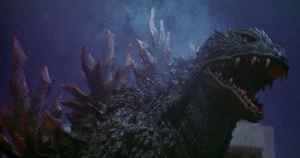 Unfortunately, now we have to get into the characterization of Godzilla here, which is the most bland and uninteresting one ever. To put it simply, he has no character here. He's just a big, rampaging monster that attacks Japan periodically and gives the human characters something to deal with and battle so they don't spend the movie standing around, doing nothing. You might ask, "Isn't that what he's always been?" Fundamentally, yeah, but there was always something about his portrayal, whether it be as an angry god punishing those who've displeased him, a reluctant protector of mankind, or a neutral force of nature that typically doesn't cause destruction intentionally, that made him stand out from all of the other movie monsters that came about during the same period as his first film. That's gone here. Like the TriStar Godzilla, he's little more than a big animal who just does what he does and happens to pose a threat to Japan in the process. Fortunately, he's shown to be cunning and instinctual, coming up with some clever, effective ways to battle the swarm of Meganulas and Megaguirus, which I'd definitely take over him just being a mindless, stupid monster, but that's all there is to him. Save for a moment where he appears to lock eyes with and recognize Tsujimori, there's no sense of higher intelligence or deep, burning hatred for mankind as there was in the previous films, including Godzilla 2000. As a result, this makes Godzilla one of the least interesting things about the movie, which is a huge mistake (particularly for a movie like this that's already pretty uninteresting as it is) and one they would repeat even worse in both of the later films that involve Mechagodzilla. It really sucks that this is how they decided to go with Godzilla in not only this film but in some later ones down the road, which is why I'm not a big fan of the Millennium series as a whole.
Unfortunately, now we have to get into the characterization of Godzilla here, which is the most bland and uninteresting one ever. To put it simply, he has no character here. He's just a big, rampaging monster that attacks Japan periodically and gives the human characters something to deal with and battle so they don't spend the movie standing around, doing nothing. You might ask, "Isn't that what he's always been?" Fundamentally, yeah, but there was always something about his portrayal, whether it be as an angry god punishing those who've displeased him, a reluctant protector of mankind, or a neutral force of nature that typically doesn't cause destruction intentionally, that made him stand out from all of the other movie monsters that came about during the same period as his first film. That's gone here. Like the TriStar Godzilla, he's little more than a big animal who just does what he does and happens to pose a threat to Japan in the process. Fortunately, he's shown to be cunning and instinctual, coming up with some clever, effective ways to battle the swarm of Meganulas and Megaguirus, which I'd definitely take over him just being a mindless, stupid monster, but that's all there is to him. Save for a moment where he appears to lock eyes with and recognize Tsujimori, there's no sense of higher intelligence or deep, burning hatred for mankind as there was in the previous films, including Godzilla 2000. As a result, this makes Godzilla one of the least interesting things about the movie, which is a huge mistake (particularly for a movie like this that's already pretty uninteresting as it is) and one they would repeat even worse in both of the later films that involve Mechagodzilla. It really sucks that this is how they decided to go with Godzilla in not only this film but in some later ones down the road, which is why I'm not a big fan of the Millennium series as a whole. 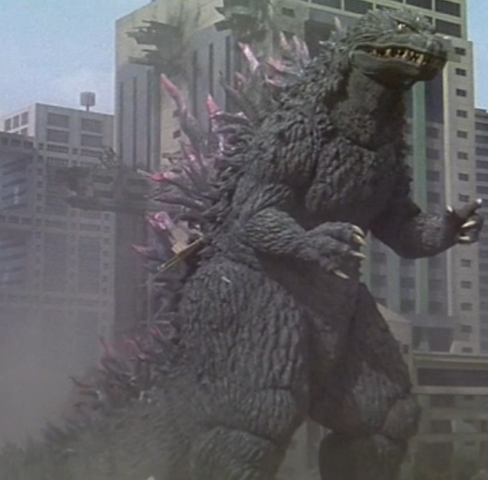
 As you've seen, even though Godzilla 2000 and Godzilla vs. Megaguirus have nothing to do with each, Godzilla's design was virtually unchanged between films. I think the colors of his green skin and purple spines (I still don't get why they went with that) are brighter and more vibrant than they were in Godzilla 2000 but other than that, everything from the skin texture, the shape of his head and mouth, and the size and shape of his spines are pretty much the same. But, even so, this is not the exact same suit that we saw in the previous film. The only reason it looks so similar is because of the molding process they were now using (if you look carefully, you can see some very subtle differences). They had to make a new suit in order to better accommodate Tsutomu Kitagawa, who had a rough time with the one he wore in Godzilla 2000. As had been the case with Haruo Nakajima and Kenpachiro Satsuma before him, his second Godzilla suit was designed to fit his specific physique perfectly, which was much more comfortable for him and allowed him to move more fluidly (even after decades of experience, it seems like they always make a bunch of miscalculations in creating the first Godzilla suit for an actor). Indeed, if you compare Godzilla's movements in both films, you will see that he's much more agile and light on his feet here and is able to pull off some more intricate fight moves. Watching him here, it's not surprising to learn that Kitagawa once had a career as a TV superhero. Incidentally, I forgot to mention in the previous review that in these films, Godzilla has been shrunk back down to his original height of 50 meters, since it was felt that he had become a little too big by the end of the Heisei series, where he had ballooned up to 100 meters. His atomic blast is the same crimson color that it was in the previous film and has the same destructive capabilities that it did as well. And as you might have guessed, they use the same roar they created for Godzilla 2000, which would become his signature sound throughout the Millennium series, although here they also use a roar that sounds very similar to the version of the classic screeching roar that was used during the latter Heisei films.
As you've seen, even though Godzilla 2000 and Godzilla vs. Megaguirus have nothing to do with each, Godzilla's design was virtually unchanged between films. I think the colors of his green skin and purple spines (I still don't get why they went with that) are brighter and more vibrant than they were in Godzilla 2000 but other than that, everything from the skin texture, the shape of his head and mouth, and the size and shape of his spines are pretty much the same. But, even so, this is not the exact same suit that we saw in the previous film. The only reason it looks so similar is because of the molding process they were now using (if you look carefully, you can see some very subtle differences). They had to make a new suit in order to better accommodate Tsutomu Kitagawa, who had a rough time with the one he wore in Godzilla 2000. As had been the case with Haruo Nakajima and Kenpachiro Satsuma before him, his second Godzilla suit was designed to fit his specific physique perfectly, which was much more comfortable for him and allowed him to move more fluidly (even after decades of experience, it seems like they always make a bunch of miscalculations in creating the first Godzilla suit for an actor). Indeed, if you compare Godzilla's movements in both films, you will see that he's much more agile and light on his feet here and is able to pull off some more intricate fight moves. Watching him here, it's not surprising to learn that Kitagawa once had a career as a TV superhero. Incidentally, I forgot to mention in the previous review that in these films, Godzilla has been shrunk back down to his original height of 50 meters, since it was felt that he had become a little too big by the end of the Heisei series, where he had ballooned up to 100 meters. His atomic blast is the same crimson color that it was in the previous film and has the same destructive capabilities that it did as well. And as you might have guessed, they use the same roar they created for Godzilla 2000, which would become his signature sound throughout the Millennium series, although here they also use a roar that sounds very similar to the version of the classic screeching roar that was used during the latter Heisei films.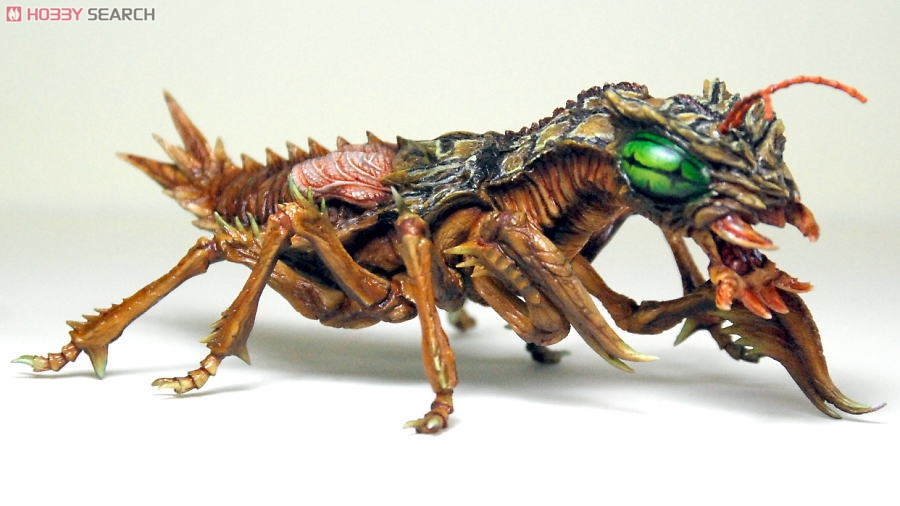
 While they look totally different, the Meganulons that first appear in this film are based on enormous insects that were the initial threat in Rodan in 1956. They first make their presence known when, after that kid dumps their egg down into the sewers beneath Tokyo, the manholes and sewer vents begin overflowing with water from whatever it is they're doing down there. They soon begin making their way up top and attack people, with one Meganulon in particular killing a young couple before climbing up the side of a building and molting into a Meganula. We don't get that good of a look at the Meganulons at first, since they're filmed in very quick cuts or in far-off shots but, we finally do get a good look when that one molts on the side of the building, we see that it fundamentally just looks like an overgrown dragonfly nymph (in close-up photos of them, I notice that they have the eyes of deerflies, which makes my skin crawl because, living in the South, I can attest to how much of a literal pain those things are). Similarly, the adult stage, which is the Meganula, just looks like a man-sized dragonfly. But, despite they're relatively small size in comparison to the other monsters in this series, particularly Godzilla himself, they make up for it in their extreme aggressiveness and destructive capabilities, able to completely flood the entire Shibuya District in Tokyo are enough time has passed. They also prove to be a persistent pest for Godzilla when they attack him, swarming all around him and biting him repeatedly on every part of his body in order to absorb as much of his energy as they can. You may think that they were attacking him simply to feed on his energy for themselves but, as it turns out, they had been following him for a long time, as shown by a satellite image of one right above him at one point, in order to collect his energy for their queen, Megaguirus, to give her the strength needed to molt into her full-blown adult form. They died upon returning to the flooded district and injecting her with the energy.
While they look totally different, the Meganulons that first appear in this film are based on enormous insects that were the initial threat in Rodan in 1956. They first make their presence known when, after that kid dumps their egg down into the sewers beneath Tokyo, the manholes and sewer vents begin overflowing with water from whatever it is they're doing down there. They soon begin making their way up top and attack people, with one Meganulon in particular killing a young couple before climbing up the side of a building and molting into a Meganula. We don't get that good of a look at the Meganulons at first, since they're filmed in very quick cuts or in far-off shots but, we finally do get a good look when that one molts on the side of the building, we see that it fundamentally just looks like an overgrown dragonfly nymph (in close-up photos of them, I notice that they have the eyes of deerflies, which makes my skin crawl because, living in the South, I can attest to how much of a literal pain those things are). Similarly, the adult stage, which is the Meganula, just looks like a man-sized dragonfly. But, despite they're relatively small size in comparison to the other monsters in this series, particularly Godzilla himself, they make up for it in their extreme aggressiveness and destructive capabilities, able to completely flood the entire Shibuya District in Tokyo are enough time has passed. They also prove to be a persistent pest for Godzilla when they attack him, swarming all around him and biting him repeatedly on every part of his body in order to absorb as much of his energy as they can. You may think that they were attacking him simply to feed on his energy for themselves but, as it turns out, they had been following him for a long time, as shown by a satellite image of one right above him at one point, in order to collect his energy for their queen, Megaguirus, to give her the strength needed to molt into her full-blown adult form. They died upon returning to the flooded district and injecting her with the energy.
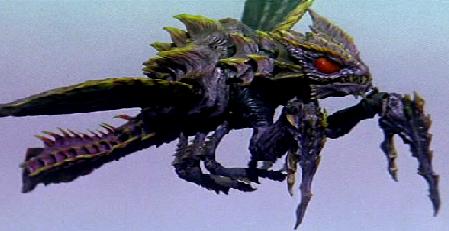 Although she proves herself to be a very difficult foe for Godzilla, Megaguirus is ultimately not very important to the film's overall plot of the humans trying to kill the Big G with Dimension Tide. Like I said in my introduction, to the humans, she and her brood are little more than an annoyance that constantly interferes with their plans to defeat Godzilla, be it by the Meganulas initially preventing Dimension Tide from locking onto Godzilla or by Megaguirus' ultra-high frequency sonic waves that are generated by her flight shorting out the equipment necessary control the weapon. For that matter, the military don't even battle Megaguirus directly, only ending up as cannon fodder for her when she first appears (that little skirmish they have with the Meganulas halfway into the movie doesn't count), and she's actually killed by Godzilla before the movie moves into its final act. That right there makes it feel like she had no significance to the plot, which is much like how Anguirus came across when Godzilla defeated him in the middle of Godzilla Raids Again. Her only purpose was to be something that Godzilla could fight and pad out the film's running time. That's a shame because Megaguirus is not a bad monster at all. First off, as someone else I know has noted before, her design is a pretty cool one, coming across like an evil, almost demonic, version of Mothra. Second, she proves herself to be a formidable foe for the Big G, able to fly circles around him with her supersonic speeds and pop up behind him or to his side when he least expects it. Her wings and claws are able to cut through steel and metal in order to drop stuff on Godzilla and the stinger at the end of her abdomen enables her to suck energy directly for his body, which weakens him to the point where he's unable to use his atomic blast while she's doing so and enables her to shoot a ball of fire at him. With all of these advantages that Megaguirus has on him, it's only through his animal cunning and instinct that Godzilla is able to turn the tables on her and defeat her. And finally, even though she's an insect, Megaguirus has something of a personality to her. While her reason for attacking Godzilla is because she now sees Tokyo as her territory and is just doing what she naturally does, there are moments where you can tell that she's enjoying putting the hurt on him, particularly in this one quick shot where she evilly sneers before dropping this big object right on top of him. Also, when Godzilla turns the tables on her during the latter part of the fight, it's obvious that Megaguirus knows she made a big mistake in challenging him. When Godzilla does that belly-flop onto her near the end of the fight, Megaguirus gets a, "Holy shit!" expression on her face when she looks up and sees him heading right for her. Since she's just a model, they had to use CGI to create these expressions and while it's obvious, it still works (Minoru Watanabe is credited with having actually played Megaguirus, although I don't know how that's possible; maybe this person was inside the model and controlled the appendages while it was pulled around?) Finally, Megaguirus' vocalization is a high-frequency scream that, to me anyway, sounds both threatening and, somehow, mournful, making me almost feel pity when Godzilla kills her (I say almost because then I remember how sadistic she was in attacking him). Not a bad kaiju, Megaguirus. Makes me wish they hadn't treated her in a manner that made her feel superfluous to the film's overall story.
Although she proves herself to be a very difficult foe for Godzilla, Megaguirus is ultimately not very important to the film's overall plot of the humans trying to kill the Big G with Dimension Tide. Like I said in my introduction, to the humans, she and her brood are little more than an annoyance that constantly interferes with their plans to defeat Godzilla, be it by the Meganulas initially preventing Dimension Tide from locking onto Godzilla or by Megaguirus' ultra-high frequency sonic waves that are generated by her flight shorting out the equipment necessary control the weapon. For that matter, the military don't even battle Megaguirus directly, only ending up as cannon fodder for her when she first appears (that little skirmish they have with the Meganulas halfway into the movie doesn't count), and she's actually killed by Godzilla before the movie moves into its final act. That right there makes it feel like she had no significance to the plot, which is much like how Anguirus came across when Godzilla defeated him in the middle of Godzilla Raids Again. Her only purpose was to be something that Godzilla could fight and pad out the film's running time. That's a shame because Megaguirus is not a bad monster at all. First off, as someone else I know has noted before, her design is a pretty cool one, coming across like an evil, almost demonic, version of Mothra. Second, she proves herself to be a formidable foe for the Big G, able to fly circles around him with her supersonic speeds and pop up behind him or to his side when he least expects it. Her wings and claws are able to cut through steel and metal in order to drop stuff on Godzilla and the stinger at the end of her abdomen enables her to suck energy directly for his body, which weakens him to the point where he's unable to use his atomic blast while she's doing so and enables her to shoot a ball of fire at him. With all of these advantages that Megaguirus has on him, it's only through his animal cunning and instinct that Godzilla is able to turn the tables on her and defeat her. And finally, even though she's an insect, Megaguirus has something of a personality to her. While her reason for attacking Godzilla is because she now sees Tokyo as her territory and is just doing what she naturally does, there are moments where you can tell that she's enjoying putting the hurt on him, particularly in this one quick shot where she evilly sneers before dropping this big object right on top of him. Also, when Godzilla turns the tables on her during the latter part of the fight, it's obvious that Megaguirus knows she made a big mistake in challenging him. When Godzilla does that belly-flop onto her near the end of the fight, Megaguirus gets a, "Holy shit!" expression on her face when she looks up and sees him heading right for her. Since she's just a model, they had to use CGI to create these expressions and while it's obvious, it still works (Minoru Watanabe is credited with having actually played Megaguirus, although I don't know how that's possible; maybe this person was inside the model and controlled the appendages while it was pulled around?) Finally, Megaguirus' vocalization is a high-frequency scream that, to me anyway, sounds both threatening and, somehow, mournful, making me almost feel pity when Godzilla kills her (I say almost because then I remember how sadistic she was in attacking him). Not a bad kaiju, Megaguirus. Makes me wish they hadn't treated her in a manner that made her feel superfluous to the film's overall story.
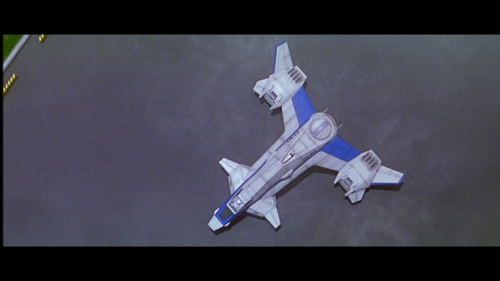 A satellite that can fire miniature black holes is definitely an outlandish weapon, even for this series, but, indeed, that's what Dimension Tide is. But, as cool as it seems, we don't see it in action that much save for a brief scene where it's tested out in the Japanese countryside and the two times they attempt to use it against Godzilla after it's launched into space. In fact, the thing kind of proves to be more than trouble than it's worth, unable to lock onto Godzilla at one point when the Meganulas are blocking its sights, actually missing him when they finally do manage to shoot it at him the first time, having to cool down for an hour before they can fire again, giving Godzilla plenty of time to get away, and being so vulnerable to Megaguirus' high-frequency that it begins plummeting out of orbit during the most critical moment. They obviously do manage to get it working and are able to fire it at Godzilla before it blows up in the atmosphere but, the biggest insult of all is that we learn that Godzilla survived and managed to escape at the end of the film. Not even a weapon that can fire black holes could stop Godzilla! They might as well just give up and let him have Japan by this point. Another bit of futuristic tech here is the Griffon, the aircraft used by the G-Graspers. It's basically just another iteration of the Super-X but is nowhere near as awesome since its only weapons are dual photon cannons that don't appear to harm Godzilla at all and, other than that, its only special attributes are its ability to fly at Mach 3, take off and land vertically (big whoop), and deploy mini boat-like tracking devices in order to keep tabs on Godzilla when he's swimming underwater. Plus, its design and paint-job hardly makes it look a genuine threat to anything, let alone Godzilla, and it only comes in handy against him when Tsujimori has to crash it into his back after Dimension Tide locks onto it in order to suck him up in the black hole.
A satellite that can fire miniature black holes is definitely an outlandish weapon, even for this series, but, indeed, that's what Dimension Tide is. But, as cool as it seems, we don't see it in action that much save for a brief scene where it's tested out in the Japanese countryside and the two times they attempt to use it against Godzilla after it's launched into space. In fact, the thing kind of proves to be more than trouble than it's worth, unable to lock onto Godzilla at one point when the Meganulas are blocking its sights, actually missing him when they finally do manage to shoot it at him the first time, having to cool down for an hour before they can fire again, giving Godzilla plenty of time to get away, and being so vulnerable to Megaguirus' high-frequency that it begins plummeting out of orbit during the most critical moment. They obviously do manage to get it working and are able to fire it at Godzilla before it blows up in the atmosphere but, the biggest insult of all is that we learn that Godzilla survived and managed to escape at the end of the film. Not even a weapon that can fire black holes could stop Godzilla! They might as well just give up and let him have Japan by this point. Another bit of futuristic tech here is the Griffon, the aircraft used by the G-Graspers. It's basically just another iteration of the Super-X but is nowhere near as awesome since its only weapons are dual photon cannons that don't appear to harm Godzilla at all and, other than that, its only special attributes are its ability to fly at Mach 3, take off and land vertically (big whoop), and deploy mini boat-like tracking devices in order to keep tabs on Godzilla when he's swimming underwater. Plus, its design and paint-job hardly makes it look a genuine threat to anything, let alone Godzilla, and it only comes in handy against him when Tsujimori has to crash it into his back after Dimension Tide locks onto it in order to suck him up in the black hole.


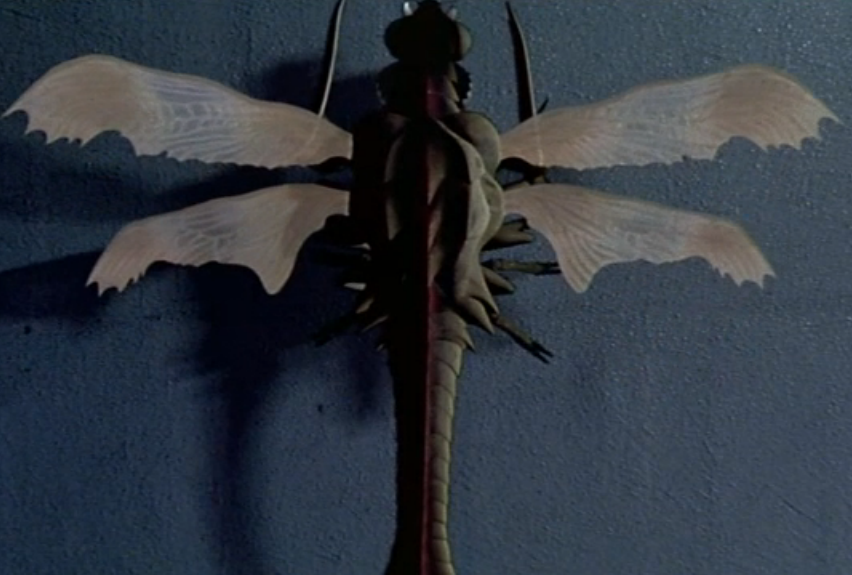
 You cannot fathom how crushing it is as a life-long fan to see that the later movies look faker than the early ones. It's very upsetting to have a bunch of people mock you for liking something that is synonymous with poor special effects and then have them virtually be proven right when the quality of the effects work gets worse in later years instead of more photorealistic. Kenji Suzuki is once again put in charge of the effects but, while he continues to try to innovate and experiment with combinations of practical monsters and models with CGI, the limited budget he had to work with is often very blatant. The Godzilla suit is not lit very well and it's painfully obvious that he's made of rubber rather than living flesh, which was not the case with the Heisei films, and the same goes for the models, which look good in wide-shots but in close-ups, they look like toys. They especially look bad during the sequence at the beginning where Godzilla attacks Osaka in 1996, where the shots of them, coupled with the quality of some of the matting effects used to put the bazooka squad in there with him, make it feel very claustrophobic, constrained, and small in scale rather big and impacting like it should be. As for the matting and opticals, some of it looks okay but there are many shots, the scene where Tsujimori rides on Godzilla's back being a prime example, where they look funky and the composited elements don't fit in color and lighting with what they're being added to. Going back to the models for a moment, Sony ended up making the marionette used for Megaguirus herself look very hokey on their DVD release of the film by brightening up the print they were given, which enables you to see the wires holding the thing up and pulling it. And as for the CGI in the film... it looks better than it did in Godzilla 2000, with the monsters' beam weapons, Dimension Tide's firing sequences, and the wormhole the first test creates looking really good, but there's still a lot of it that looks very bad, like the CGI Meganulas and the shots of Godzilla swimming underwater. The green screen effects are also improved from the previous film but there are still some that look wonky. And finally, there are some more of those really cheap-looking shaking and jittering camera effects that I wish they wouldn't do because, again, it makes it look like a micro-budget, direct-to-video movie that's trying desperately to look more impressive. Plus, the awkward slow motion shots that you see from Megaguirus' POV could have been axed. Now, there is some good effects work in the film, with the matting of the current Godzilla into footage from the original 1954 movie being particularly impressive, as is some of the stuff you see during Godzilla and Megaguirus' big battle (which is actually the best sequence in the entire film), but on the whole, the effects still leave a lot to be desired for. It seems like Suzuki took a lot of the blame for why the film bombed at the Japanese box-office and, as a result, he never supervised the effects on another Godzilla movie, a punishment that I do think is a bit harsh and unfair. The effects are hardly the only problem with this film.
You cannot fathom how crushing it is as a life-long fan to see that the later movies look faker than the early ones. It's very upsetting to have a bunch of people mock you for liking something that is synonymous with poor special effects and then have them virtually be proven right when the quality of the effects work gets worse in later years instead of more photorealistic. Kenji Suzuki is once again put in charge of the effects but, while he continues to try to innovate and experiment with combinations of practical monsters and models with CGI, the limited budget he had to work with is often very blatant. The Godzilla suit is not lit very well and it's painfully obvious that he's made of rubber rather than living flesh, which was not the case with the Heisei films, and the same goes for the models, which look good in wide-shots but in close-ups, they look like toys. They especially look bad during the sequence at the beginning where Godzilla attacks Osaka in 1996, where the shots of them, coupled with the quality of some of the matting effects used to put the bazooka squad in there with him, make it feel very claustrophobic, constrained, and small in scale rather big and impacting like it should be. As for the matting and opticals, some of it looks okay but there are many shots, the scene where Tsujimori rides on Godzilla's back being a prime example, where they look funky and the composited elements don't fit in color and lighting with what they're being added to. Going back to the models for a moment, Sony ended up making the marionette used for Megaguirus herself look very hokey on their DVD release of the film by brightening up the print they were given, which enables you to see the wires holding the thing up and pulling it. And as for the CGI in the film... it looks better than it did in Godzilla 2000, with the monsters' beam weapons, Dimension Tide's firing sequences, and the wormhole the first test creates looking really good, but there's still a lot of it that looks very bad, like the CGI Meganulas and the shots of Godzilla swimming underwater. The green screen effects are also improved from the previous film but there are still some that look wonky. And finally, there are some more of those really cheap-looking shaking and jittering camera effects that I wish they wouldn't do because, again, it makes it look like a micro-budget, direct-to-video movie that's trying desperately to look more impressive. Plus, the awkward slow motion shots that you see from Megaguirus' POV could have been axed. Now, there is some good effects work in the film, with the matting of the current Godzilla into footage from the original 1954 movie being particularly impressive, as is some of the stuff you see during Godzilla and Megaguirus' big battle (which is actually the best sequence in the entire film), but on the whole, the effects still leave a lot to be desired for. It seems like Suzuki took a lot of the blame for why the film bombed at the Japanese box-office and, as a result, he never supervised the effects on another Godzilla movie, a punishment that I do think is a bit harsh and unfair. The effects are hardly the only problem with this film. 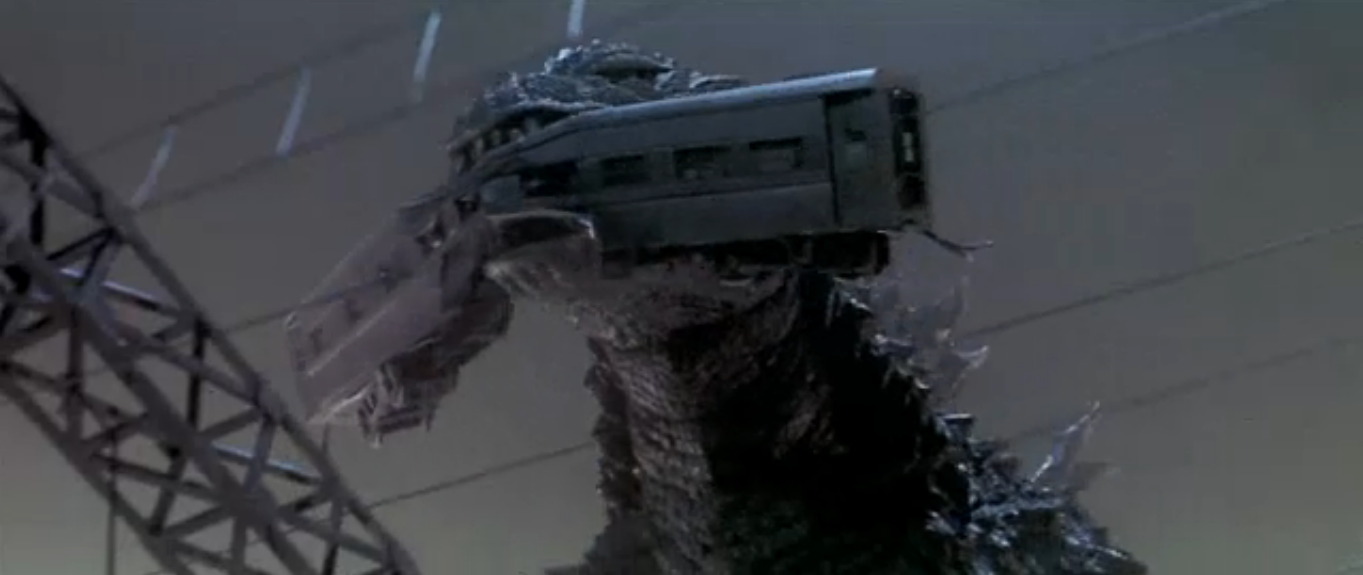

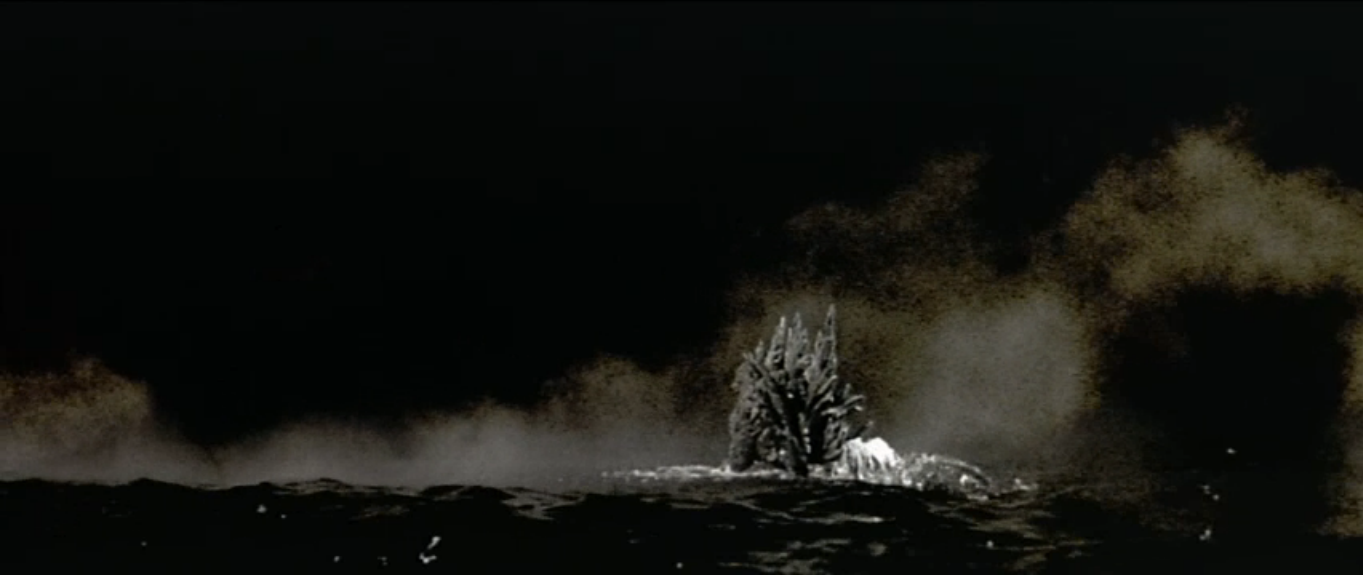


 Toho caught some flack for the small amount of monster action in Godzilla 2000, so they decided they'd better up the ante with this one, which they did. At the very beginning of the film, we get an old-time newsflash from 1954 about Godzilla's attack on Tokyo and jump right into the recreation of key scenes from the original movie. As I said, despite what the movie leads into, it's quite cool seeing this modern-designed Godzilla placed into the old footage here, be it via advanced matting processes or by shooting new shots in monochrome. After the classic shot of the Tokyo skyline in flames, we get a recreation of the shot of Godzilla with that train car in his mouth, followed by some tweaking of the shot of people running in the foreground as he approaches the railroad tracks in the background. We then get a new shot of him firing his atomic blast that's followed by the splicing of it into an actual shot of a building from the original film. Another shot from that film of the city in flames and a new shot of Godzilla's head looming over the skyline is followed up by recreations of the iconic visuals of him looming behind the Diet Building and walking through the flaming cityscape before he finally returns to the sea (again, really cool stuff). After a little bit of business where we're told that Tokyo underwent massive reconstruction and that the capital was moved to Osaka, we fast-forward to 1966, when Godzilla returns and attacks Tokai Village for Japan's first nuclear power plant (note that Tokai was the same area he headed for in the previous film). The brief scene of him tearing through the back of the plant, smashing through the building and a smokestack, to get to the reactor, while panicked workers flee in the foreground, is very reminiscent of his first appearance in The Return of Godzilla and it's filmed in a "dirtier," less cleaned up way that harkens back to the way the films of the 60's look. We then get some more exposition about how the decision was made to give up on nuclear power to dissuade Godzilla from attacking further (we get a government meeting here that is almost identical to the one in the original Godzilla, right down to a woman representative shouting at someone from across the room; the men here kind of remind of people we've saw in similar scenes in Ghidorah, the Three-Headed Monster and Godzilla vs. Monster Zero). But, we're told that, despite the country's attempts to use more clean energy for electricity, nothing could replace nuclear energy and so, we cut to Osaka in 1996 where we see the establishment of the Bureau of Science and Technology and meet Sugiura as he unveils the concept of plasma energy to the public. The narrator, who has been talking this whole time, tells us that plasma energy became the standard energy source for the country. But, it ended up not mattering...
Toho caught some flack for the small amount of monster action in Godzilla 2000, so they decided they'd better up the ante with this one, which they did. At the very beginning of the film, we get an old-time newsflash from 1954 about Godzilla's attack on Tokyo and jump right into the recreation of key scenes from the original movie. As I said, despite what the movie leads into, it's quite cool seeing this modern-designed Godzilla placed into the old footage here, be it via advanced matting processes or by shooting new shots in monochrome. After the classic shot of the Tokyo skyline in flames, we get a recreation of the shot of Godzilla with that train car in his mouth, followed by some tweaking of the shot of people running in the foreground as he approaches the railroad tracks in the background. We then get a new shot of him firing his atomic blast that's followed by the splicing of it into an actual shot of a building from the original film. Another shot from that film of the city in flames and a new shot of Godzilla's head looming over the skyline is followed up by recreations of the iconic visuals of him looming behind the Diet Building and walking through the flaming cityscape before he finally returns to the sea (again, really cool stuff). After a little bit of business where we're told that Tokyo underwent massive reconstruction and that the capital was moved to Osaka, we fast-forward to 1966, when Godzilla returns and attacks Tokai Village for Japan's first nuclear power plant (note that Tokai was the same area he headed for in the previous film). The brief scene of him tearing through the back of the plant, smashing through the building and a smokestack, to get to the reactor, while panicked workers flee in the foreground, is very reminiscent of his first appearance in The Return of Godzilla and it's filmed in a "dirtier," less cleaned up way that harkens back to the way the films of the 60's look. We then get some more exposition about how the decision was made to give up on nuclear power to dissuade Godzilla from attacking further (we get a government meeting here that is almost identical to the one in the original Godzilla, right down to a woman representative shouting at someone from across the room; the men here kind of remind of people we've saw in similar scenes in Ghidorah, the Three-Headed Monster and Godzilla vs. Monster Zero). But, we're told that, despite the country's attempts to use more clean energy for electricity, nothing could replace nuclear energy and so, we cut to Osaka in 1996 where we see the establishment of the Bureau of Science and Technology and meet Sugiura as he unveils the concept of plasma energy to the public. The narrator, who has been talking this whole time, tells us that plasma energy became the standard energy source for the country. But, it ended up not mattering...
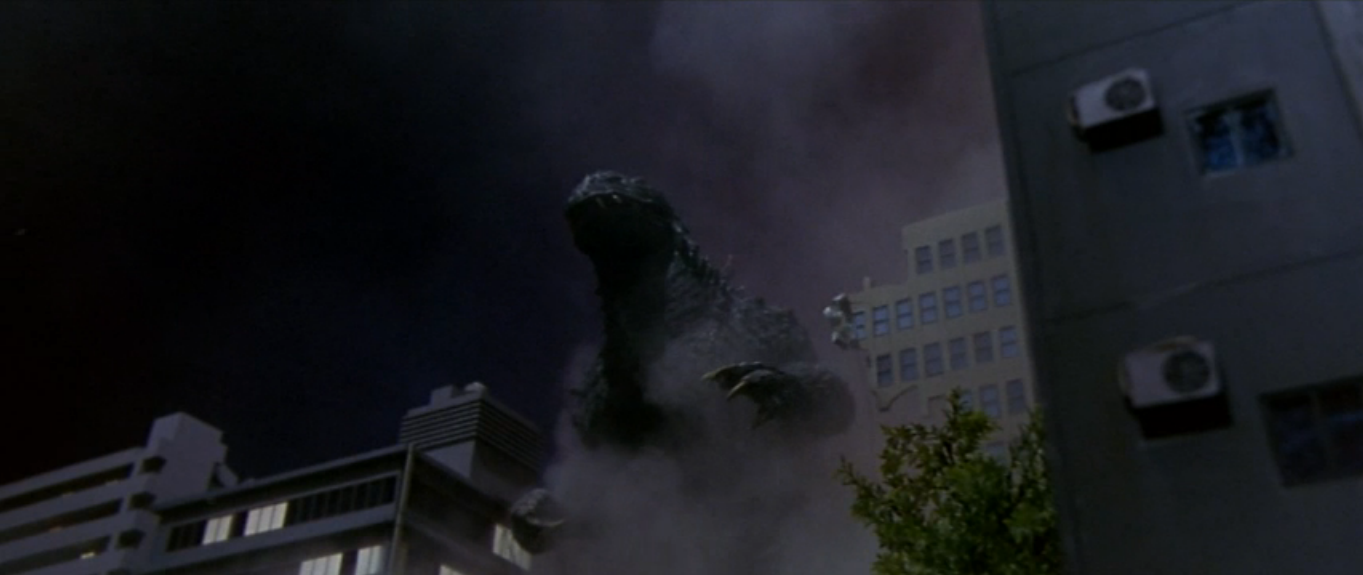
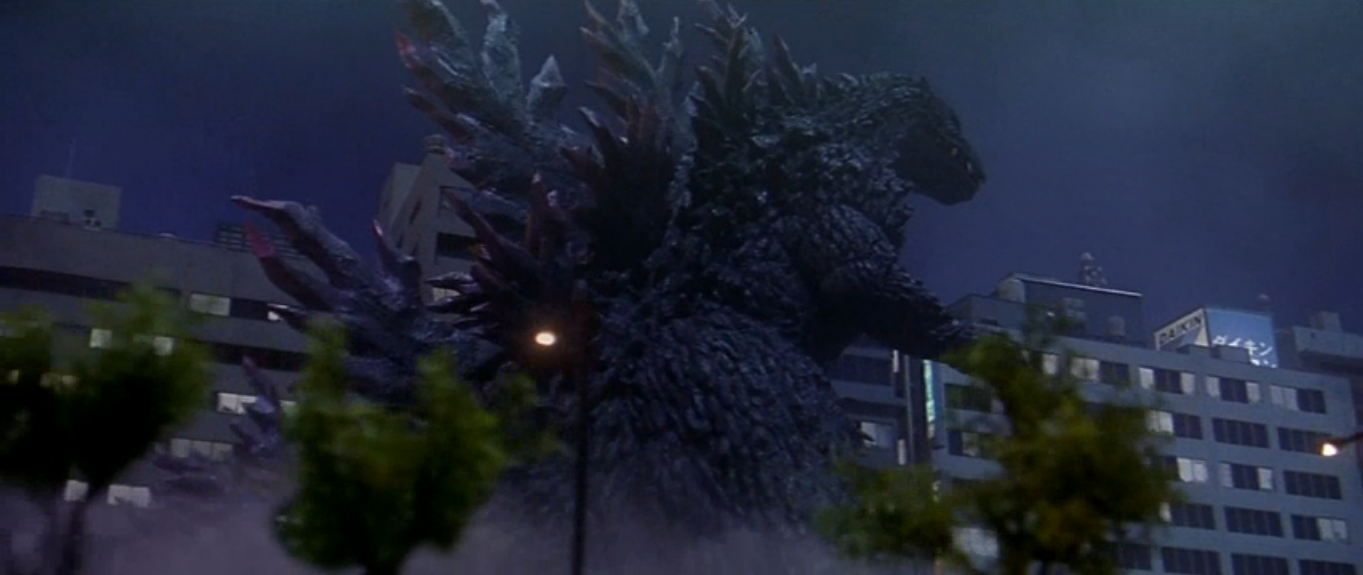

 The film cuts to Nakanoshima, Osaka, where a bazooka unit is being driven in to the area to deal with Godzilla, who has returned. This is where we're introduced to Tsujimori and her commanding officer, Miyagawa. As they climb out of their vehicles, they hear a crash that's followed by Godzilla's roar and, once the spotlights are turned on him, we see him smash through a building on the other side of the street. The unit goes into action, as Godzilla enters into the heart of the city. They split up into different squads to try to head Godzilla off in the hopes that shooting him in the legs will bring him down (a rather optimistic bunch, aren't they?) Miyagawa leads a couple of other people along the outskirts of the buildings, keeping an eye on Godzilla on the other side, and get into position on one side of an alleyway facing the street. The place begins to shake as Godzilla approaches, knocking over some garbage cans (this is when the miniatures look very weak) and a flaming car flies past the mouth of the alley and explodes out of sight before Godzilla smashes his foot down there. They fire their bazookas and manage to hit his legs but all that does is enrage him and prompt him to try to squeeze in-between the buildings to get at them. He smashes the sides of both buildings when he's tagged on the back by another squad, which makes him lurch out of the alley and head down the street. Miyagawa and his crew end up behind Godzilla while another squad gets caught on the street in front of him. The other squads fire on him to drive him away, while Tsujimori is ordered to get into position down the street. As he heads down the street, Godzilla smashes the side of a building and takes out one squad. Another squad attempts to outflank him as he continues down the street and run down the sidewalk to his right before stopping him and blasting him in the side of the head. This prompts Godzilla to turn, look right at them, and roar, which gives them the incentive to take off down the alley behind them. They're not quick enough, though, as Godzilla smashes the front of the alley with his tail and sends them flying through the air. Miyagawa realizes that he's just lost two squads and hears that Godzilla is heading for the industrial areas, which is where Tsujimori is waiting for him. Seeing him round the corner of the building in front of her at first freaks her out but, she manages to keep it together and fire a shell that hits him at the base of his neck. This does make Godzilla recoil and roar but he's undeterred and continues his advancement. Tsujimori quickly loads another shell and prepares for another shot but Miyagawa shows up and, knowing that they've failed, tells her that they have to get out. Tsujimori is intent upon getting another shot but her superior then orders her to leave and the two of them begin to run. That's when Godzilla reaches the industrial building right next to them and smashes the side of it, sending a large, metal walkway hurtling towards them. Miyagawa pushes Tsujimori out of the way but he's crushed by the walkway and some large slabs of concrete that also fall. Tsujimori quickly comes to and turns around to see her superior's legs sticking out from beneath the rubble. She then takes his dog-tags and, upon looking up to see Godzilla continuing to smash the building, she screams in rage, grabs her bazooka, and takes a shot at the camera, which leads us into the film's title.
The film cuts to Nakanoshima, Osaka, where a bazooka unit is being driven in to the area to deal with Godzilla, who has returned. This is where we're introduced to Tsujimori and her commanding officer, Miyagawa. As they climb out of their vehicles, they hear a crash that's followed by Godzilla's roar and, once the spotlights are turned on him, we see him smash through a building on the other side of the street. The unit goes into action, as Godzilla enters into the heart of the city. They split up into different squads to try to head Godzilla off in the hopes that shooting him in the legs will bring him down (a rather optimistic bunch, aren't they?) Miyagawa leads a couple of other people along the outskirts of the buildings, keeping an eye on Godzilla on the other side, and get into position on one side of an alleyway facing the street. The place begins to shake as Godzilla approaches, knocking over some garbage cans (this is when the miniatures look very weak) and a flaming car flies past the mouth of the alley and explodes out of sight before Godzilla smashes his foot down there. They fire their bazookas and manage to hit his legs but all that does is enrage him and prompt him to try to squeeze in-between the buildings to get at them. He smashes the sides of both buildings when he's tagged on the back by another squad, which makes him lurch out of the alley and head down the street. Miyagawa and his crew end up behind Godzilla while another squad gets caught on the street in front of him. The other squads fire on him to drive him away, while Tsujimori is ordered to get into position down the street. As he heads down the street, Godzilla smashes the side of a building and takes out one squad. Another squad attempts to outflank him as he continues down the street and run down the sidewalk to his right before stopping him and blasting him in the side of the head. This prompts Godzilla to turn, look right at them, and roar, which gives them the incentive to take off down the alley behind them. They're not quick enough, though, as Godzilla smashes the front of the alley with his tail and sends them flying through the air. Miyagawa realizes that he's just lost two squads and hears that Godzilla is heading for the industrial areas, which is where Tsujimori is waiting for him. Seeing him round the corner of the building in front of her at first freaks her out but, she manages to keep it together and fire a shell that hits him at the base of his neck. This does make Godzilla recoil and roar but he's undeterred and continues his advancement. Tsujimori quickly loads another shell and prepares for another shot but Miyagawa shows up and, knowing that they've failed, tells her that they have to get out. Tsujimori is intent upon getting another shot but her superior then orders her to leave and the two of them begin to run. That's when Godzilla reaches the industrial building right next to them and smashes the side of it, sending a large, metal walkway hurtling towards them. Miyagawa pushes Tsujimori out of the way but he's crushed by the walkway and some large slabs of concrete that also fall. Tsujimori quickly comes to and turns around to see her superior's legs sticking out from beneath the rubble. She then takes his dog-tags and, upon looking up to see Godzilla continuing to smash the building, she screams in rage, grabs her bazooka, and takes a shot at the camera, which leads us into the film's title. 
 The film cuts to five years later in 2001 and introduces Kudo, who is soon introduced himself to Tsujimori, who takes him to G-Grasper headquarters, introduces him to the rest of the team, tells him of their operation, and reintroduces him to Dr. Yoshizawa. We learn what happened to her colleagues and she tells Kudo of the Dimension Tide project and shows him a rather cool computer simulation of what will happen if it succeeds, which prompts him to agree to work with them. During this meeting, they get an indication that Godzilla might be coming back soon when they detect a rise in the water temperature in the Japan Trench. They're unable to determine if this disturbance is Godzilla because the anomaly quickly vanishes from view but Tsujimori decides to send out a reconnaissance just in case. As she does so, Sugiura tells Yoshizawa that they'd better get Dimension Tide up and running as soon as possible. The film cuts to three months later in a rural area near a small village and we meet the kid, Jun, as he heads out to show a friend of his some insects. That's when he stumbles across the test site of Dimension Tide after coming across a barrier in the road that forces him to cut through the woods. He reaches the edge of the forest and comes upon a field where everyone is setting the device up to test it on an old, abandoned building. Once all the preparations are finished and the area in front of the building is cleared, Dimension Tide is powered up and fired for the first time. The effects of the miniature black hole building up inside of the device's cannon and being fired straight ahead are very well done and so are the physical effects of the old warehouse being sucked up and instantly vanishing once the hole hits it. Although the test is successful, they notice the shimmering wormhole that it left behind but decide it's not worth worrying about when it seems to disappear. But, that's when Jun is caught snooping around the edge of the forest and is confronted by Tsujimori, who very gently asks him not to tell anyone, not even his parents, about what he just saw and sends him on his way.
The film cuts to five years later in 2001 and introduces Kudo, who is soon introduced himself to Tsujimori, who takes him to G-Grasper headquarters, introduces him to the rest of the team, tells him of their operation, and reintroduces him to Dr. Yoshizawa. We learn what happened to her colleagues and she tells Kudo of the Dimension Tide project and shows him a rather cool computer simulation of what will happen if it succeeds, which prompts him to agree to work with them. During this meeting, they get an indication that Godzilla might be coming back soon when they detect a rise in the water temperature in the Japan Trench. They're unable to determine if this disturbance is Godzilla because the anomaly quickly vanishes from view but Tsujimori decides to send out a reconnaissance just in case. As she does so, Sugiura tells Yoshizawa that they'd better get Dimension Tide up and running as soon as possible. The film cuts to three months later in a rural area near a small village and we meet the kid, Jun, as he heads out to show a friend of his some insects. That's when he stumbles across the test site of Dimension Tide after coming across a barrier in the road that forces him to cut through the woods. He reaches the edge of the forest and comes upon a field where everyone is setting the device up to test it on an old, abandoned building. Once all the preparations are finished and the area in front of the building is cleared, Dimension Tide is powered up and fired for the first time. The effects of the miniature black hole building up inside of the device's cannon and being fired straight ahead are very well done and so are the physical effects of the old warehouse being sucked up and instantly vanishing once the hole hits it. Although the test is successful, they notice the shimmering wormhole that it left behind but decide it's not worth worrying about when it seems to disappear. But, that's when Jun is caught snooping around the edge of the forest and is confronted by Tsujimori, who very gently asks him not to tell anyone, not even his parents, about what he just saw and sends him on his way. That night, Jun is laying on his futon when he hears a loud whooshing noise outside. Turning around, he sees the shadow of a huge insect pass over the closed curtains of the window, which, not surprisingly causes his eyes to widen in fear. But then, he does something completely unexpected and heads outside into the woods with a flashlight in order to look for it. He walks to the edge of the woods again and sees the shimmering wormhole in mid-air in the field where the test took place that day. Hearing a loud, shrill noise behind him, he turns around and watches the big bug fly over him through the treetops and head straight for the wormhole, disappearing within it. Freaking out, Jun backs up and begins to run back to his house when he comes across a large egg that the bug left behind on the ground. Instead of freaking out, Jun picks the wet thing up out of the puddle it's lying in and takes it home with him. Some time later, he and his family have moved to an apartment in the Shibuya District in Tokyo and Jun notices that the box he's keeping the egg in is beginning to become rather moist and fluid is leaking through its bottom. Deciding that he'd best get rid of it, Jun picks the box up but the cardboard has become so dampened that the egg goes right through the bottom. A cut shows him walking down the sidewalk next to his building with the egg in a plastic bag. He tries to put in a spot where the garbage is picked up but a nearby woman tells him that there's no trash collection that day and he'll have to come back tomorrow. Jun picks the bag back up and walks further down the street, looking for somewhere to dump it. Spying a sewer vent, he lifts the lid off of it and dumps the egg, which had filled with the bag with fluid, into the small tunnel, which it tumbles down until falling into the main sewer system. With that task done, Jun closes the vent and runs back home.
That night, Jun is laying on his futon when he hears a loud whooshing noise outside. Turning around, he sees the shadow of a huge insect pass over the closed curtains of the window, which, not surprisingly causes his eyes to widen in fear. But then, he does something completely unexpected and heads outside into the woods with a flashlight in order to look for it. He walks to the edge of the woods again and sees the shimmering wormhole in mid-air in the field where the test took place that day. Hearing a loud, shrill noise behind him, he turns around and watches the big bug fly over him through the treetops and head straight for the wormhole, disappearing within it. Freaking out, Jun backs up and begins to run back to his house when he comes across a large egg that the bug left behind on the ground. Instead of freaking out, Jun picks the wet thing up out of the puddle it's lying in and takes it home with him. Some time later, he and his family have moved to an apartment in the Shibuya District in Tokyo and Jun notices that the box he's keeping the egg in is beginning to become rather moist and fluid is leaking through its bottom. Deciding that he'd best get rid of it, Jun picks the box up but the cardboard has become so dampened that the egg goes right through the bottom. A cut shows him walking down the sidewalk next to his building with the egg in a plastic bag. He tries to put in a spot where the garbage is picked up but a nearby woman tells him that there's no trash collection that day and he'll have to come back tomorrow. Jun picks the bag back up and walks further down the street, looking for somewhere to dump it. Spying a sewer vent, he lifts the lid off of it and dumps the egg, which had filled with the bag with fluid, into the small tunnel, which it tumbles down until falling into the main sewer system. With that task done, Jun closes the vent and runs back home.

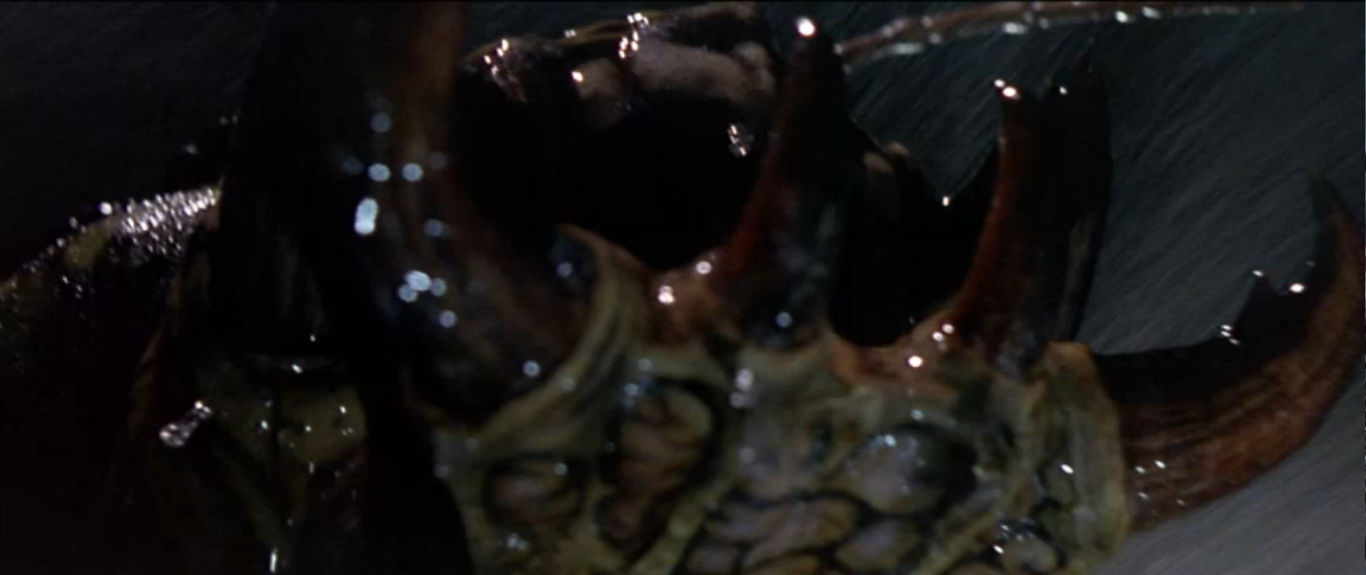

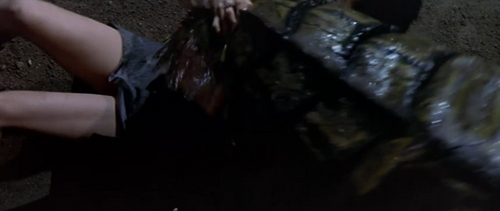
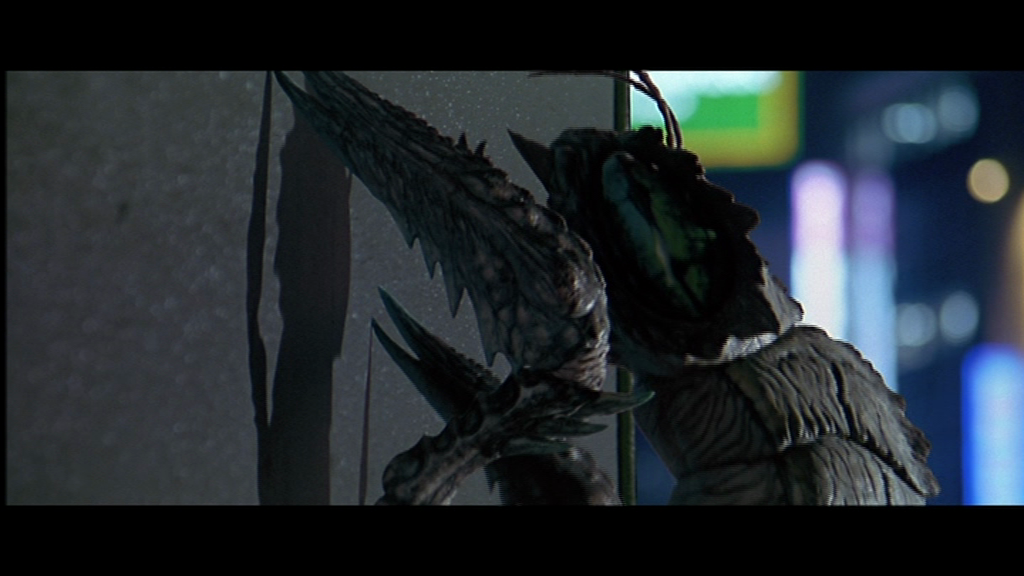
 Following a scene where Kudo gives Tsujimori the bullet that functions as a homing transmitter and finds out about Miyagawa, the film cuts back to a busy nighttime scene in Shibuya, with the camera panning down beneath the street to show the egg sitting there underwater in the sewer system. The hundreds of tiny eggs that are attached to the main one are beginning to detach and float off further down into the sewers. A little while later, Jun is coming home from school one day when he notices that water is bubbling up through the concrete in the middle of a small alleyway. It's obvious that he knows that this has something to do with the egg but he decides to ignore it and turns and runs home. That night, two guys from the water department are sent out to investigate another bit of overflow elsewhere in the city and decide that they might have to call an excavator to dig the street up in order to get at the leak. The whole time they're talking, neither of them notice the big dragonfly nymph, a Meganulon, hanging on the side of the building behind them. This leads to a moment where the film becomes like a slasher movie when a teenage couple is walking down the street and the girl tells the guy that she'll got the nearby store to get them some drinks, leaving the guy to wander off and wait for her at a small section near a construction site. The guy sits down and lights a cigarette while listening to his Walkman, which prevents him from noticing that something violently shakes the small sign off to his left from behind. He's then immediately attacked by the Meganulon, which jumps at him, smacks him in the stomach with a claw, grabs his head, and apparently stabs him in the back of it (the editing is so quick and chaotic, with quick close-ups of the creature and its victim, that it's hard to tell), causing him to spit up a mouthful of blood in a pretty gruesome shot for a Godzilla movie. The bug then finishes him off from the front and squirts some nasty-looking goo on the side of the wall as we hear a fleshy crunch off-camera. That's when his girlfriend comes back with his beer but only finds his slime-covered headphones on the ground. As he looks at them, the Meganulon drops on the ground behind her and when she turns around upon hearing the noise, it shoots her in the face with slime before lunging at her, knocking her to the ground, and dragging her behind the enclosed sign it came up from behind earlier, where we can hear it kill her as the sign shakes. Having killed those two people, the Meganulon crawls up the side of the building and immediately begins to molt. The practical effects of its shell splitting open look decent but the CGI shots of it crawling up there, the newly-formed Meganula emerging from the shell, and its wings growing into place look really bad. Elsewhere, Jun is looking out his window over the city when he sees the Meganula flying above the skyline. It gradually gets closer as he watches until it swoops toward his window and heads straight up, scaring him so badly that he falls out of his chair. The scene ends on a corny shot of his insect book, which got blown off the desk, as the pages turn from the gust of air until they end up on the entry about the type of insect he just saw. It's followed by a moment where Jun meets up with Tsujimori and tells her what he saw and what kind of insect he thinks it was using that aforementioned section in his book.
Following a scene where Kudo gives Tsujimori the bullet that functions as a homing transmitter and finds out about Miyagawa, the film cuts back to a busy nighttime scene in Shibuya, with the camera panning down beneath the street to show the egg sitting there underwater in the sewer system. The hundreds of tiny eggs that are attached to the main one are beginning to detach and float off further down into the sewers. A little while later, Jun is coming home from school one day when he notices that water is bubbling up through the concrete in the middle of a small alleyway. It's obvious that he knows that this has something to do with the egg but he decides to ignore it and turns and runs home. That night, two guys from the water department are sent out to investigate another bit of overflow elsewhere in the city and decide that they might have to call an excavator to dig the street up in order to get at the leak. The whole time they're talking, neither of them notice the big dragonfly nymph, a Meganulon, hanging on the side of the building behind them. This leads to a moment where the film becomes like a slasher movie when a teenage couple is walking down the street and the girl tells the guy that she'll got the nearby store to get them some drinks, leaving the guy to wander off and wait for her at a small section near a construction site. The guy sits down and lights a cigarette while listening to his Walkman, which prevents him from noticing that something violently shakes the small sign off to his left from behind. He's then immediately attacked by the Meganulon, which jumps at him, smacks him in the stomach with a claw, grabs his head, and apparently stabs him in the back of it (the editing is so quick and chaotic, with quick close-ups of the creature and its victim, that it's hard to tell), causing him to spit up a mouthful of blood in a pretty gruesome shot for a Godzilla movie. The bug then finishes him off from the front and squirts some nasty-looking goo on the side of the wall as we hear a fleshy crunch off-camera. That's when his girlfriend comes back with his beer but only finds his slime-covered headphones on the ground. As he looks at them, the Meganulon drops on the ground behind her and when she turns around upon hearing the noise, it shoots her in the face with slime before lunging at her, knocking her to the ground, and dragging her behind the enclosed sign it came up from behind earlier, where we can hear it kill her as the sign shakes. Having killed those two people, the Meganulon crawls up the side of the building and immediately begins to molt. The practical effects of its shell splitting open look decent but the CGI shots of it crawling up there, the newly-formed Meganula emerging from the shell, and its wings growing into place look really bad. Elsewhere, Jun is looking out his window over the city when he sees the Meganula flying above the skyline. It gradually gets closer as he watches until it swoops toward his window and heads straight up, scaring him so badly that he falls out of his chair. The scene ends on a corny shot of his insect book, which got blown off the desk, as the pages turn from the gust of air until they end up on the entry about the type of insect he just saw. It's followed by a moment where Jun meets up with Tsujimori and tells her what he saw and what kind of insect he thinks it was using that aforementioned section in his book.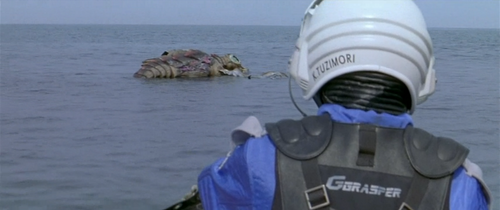
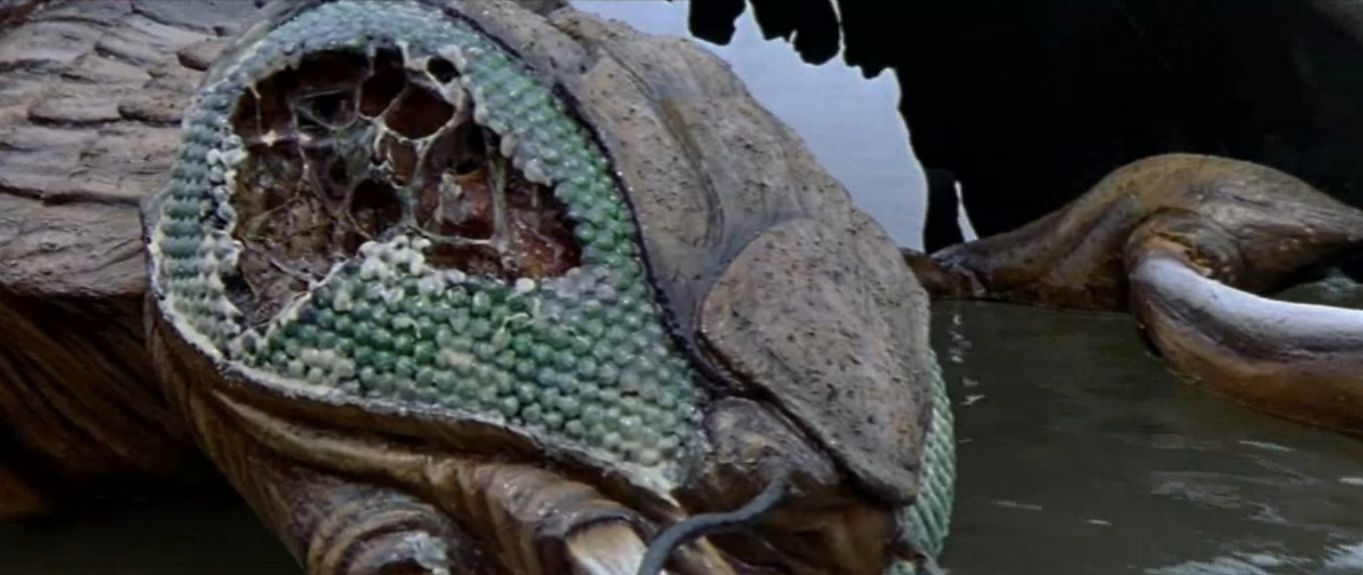 Tsujimori is then called back to G-Grasper headquarters, where she's shown that one of their satellites is picking up something off of Ogasawara Island in the Pacific. Tsujimori orders the image to be zoomed in on and when it is, even though a lot of it is blocked by the readings of extreme heat, they can just make out the image of Godzilla. They also see a dark object of the image's rear, which Tsujimori can identify as a Meganula from its outline. Confirmation of radioactivity then proves that it is indeed Godzilla, prompting Tsujimori to send out a Code Orange alert before heading off to the site with Hosono and Okumura in the Griffon (in some of these shots, its painfully obvious that the Griffon is nothing more than a model). Upon reaching the area, they discover the corpse of a Meganula floating on the water's surface. Tsujimori orders the Griffon to be put on vertical flight while she and Okumura deploy an inflatable watercraft down below and then slide down a line onto it. They then maneuver over towards the dead Meganula, with Okumura mentioning how bad it smells when they get close to it before he puts an underwater microphone beneath.
Tsujimori is then called back to G-Grasper headquarters, where she's shown that one of their satellites is picking up something off of Ogasawara Island in the Pacific. Tsujimori orders the image to be zoomed in on and when it is, even though a lot of it is blocked by the readings of extreme heat, they can just make out the image of Godzilla. They also see a dark object of the image's rear, which Tsujimori can identify as a Meganula from its outline. Confirmation of radioactivity then proves that it is indeed Godzilla, prompting Tsujimori to send out a Code Orange alert before heading off to the site with Hosono and Okumura in the Griffon (in some of these shots, its painfully obvious that the Griffon is nothing more than a model). Upon reaching the area, they discover the corpse of a Meganula floating on the water's surface. Tsujimori orders the Griffon to be put on vertical flight while she and Okumura deploy an inflatable watercraft down below and then slide down a line onto it. They then maneuver over towards the dead Meganula, with Okumura mentioning how bad it smells when they get close to it before he puts an underwater microphone beneath. 

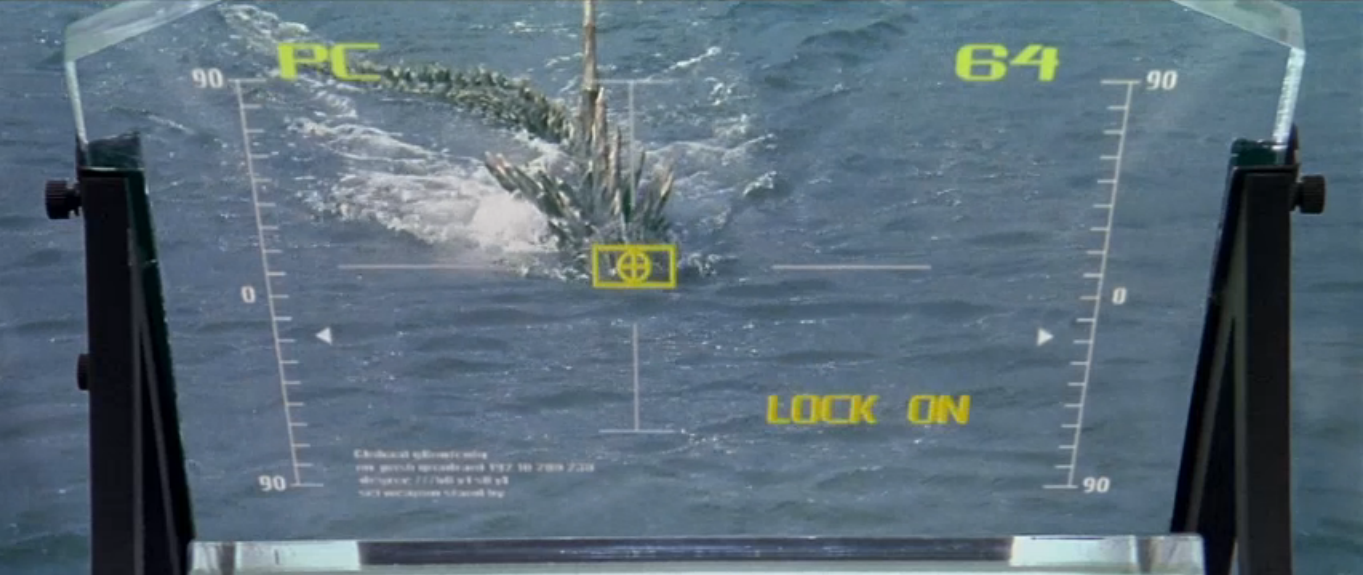

 A little while later, as they're collecting a sample from the dead bug, the two of them are told by headquarters that they're picking up a signal from Godzilla on the underwater mike. After an underwater shot where we see Godzilla's spines as he rises to the surface, they're told that he's right underneath them. Sure enough, the water beneath them begins to swell and churn violently and Tsujimori, knowing what she has to do, attaches the line they slide down to Okumura's back and he's then pulled back up into the Griffon. She then prepares herself, lowering the visor on her helmet, putting on an oxygen mask, and inflating the vest of her uniform, as Godzilla's spines break the surface right in front of her small boat. He then dunks his head back beneath the water and causes enough of a wave to fling the boat and send Tsujimori flying. Seeing that their major is in danger, Hosono locks the Griffon's weapon systems onto Godzilla but Okumura tells him not to fire because he might hit Tsujimori. Coming back to the surface, Tsujimori turns to see Godzilla slowly swimming away. Desperate not to lose him, Tsujimori swims up to his side and grabs onto one of his rock-hard scales, pulling herself up onto the base of one of his spines. She rides on Godzilla's back for a little bit and then, pulls out a pistol containing the transmitter bullet that Kudo gave her earlier. Godzilla turns his head and roars, completely oblivious to her hanging onto him, and splashes his head down into the water again. Managing to keep her grip, Tsujimori takes her chance and successfully fires the transmitter onto one of Godzilla's scales. As Godzilla pulls his head back on the surface, Tsujimori either jumps off of him or falls off back into the water. Worrying for the major's safety while Godzilla still floats there, Okumura tells Hosono to try to get the monster's attention with the Griffon. He flies the craft right in front of Godzilla's head but he responds by diving his head back beneath the water and proceeding to swim off. Tsujimori then comes back to the surface and tells Okumura about the transmitter and to send out an SGS (Search-Godzilla System) receiver to keep tabs on him. As she watches him swim away and sink beneath the surface, Tsujimori yells at Godzilla, saying that he won't get away this time. The SGS is then deployed after him as the scene ends.
A little while later, as they're collecting a sample from the dead bug, the two of them are told by headquarters that they're picking up a signal from Godzilla on the underwater mike. After an underwater shot where we see Godzilla's spines as he rises to the surface, they're told that he's right underneath them. Sure enough, the water beneath them begins to swell and churn violently and Tsujimori, knowing what she has to do, attaches the line they slide down to Okumura's back and he's then pulled back up into the Griffon. She then prepares herself, lowering the visor on her helmet, putting on an oxygen mask, and inflating the vest of her uniform, as Godzilla's spines break the surface right in front of her small boat. He then dunks his head back beneath the water and causes enough of a wave to fling the boat and send Tsujimori flying. Seeing that their major is in danger, Hosono locks the Griffon's weapon systems onto Godzilla but Okumura tells him not to fire because he might hit Tsujimori. Coming back to the surface, Tsujimori turns to see Godzilla slowly swimming away. Desperate not to lose him, Tsujimori swims up to his side and grabs onto one of his rock-hard scales, pulling herself up onto the base of one of his spines. She rides on Godzilla's back for a little bit and then, pulls out a pistol containing the transmitter bullet that Kudo gave her earlier. Godzilla turns his head and roars, completely oblivious to her hanging onto him, and splashes his head down into the water again. Managing to keep her grip, Tsujimori takes her chance and successfully fires the transmitter onto one of Godzilla's scales. As Godzilla pulls his head back on the surface, Tsujimori either jumps off of him or falls off back into the water. Worrying for the major's safety while Godzilla still floats there, Okumura tells Hosono to try to get the monster's attention with the Griffon. He flies the craft right in front of Godzilla's head but he responds by diving his head back beneath the water and proceeding to swim off. Tsujimori then comes back to the surface and tells Okumura about the transmitter and to send out an SGS (Search-Godzilla System) receiver to keep tabs on him. As she watches him swim away and sink beneath the surface, Tsujimori yells at Godzilla, saying that he won't get away this time. The SGS is then deployed after him as the scene ends. 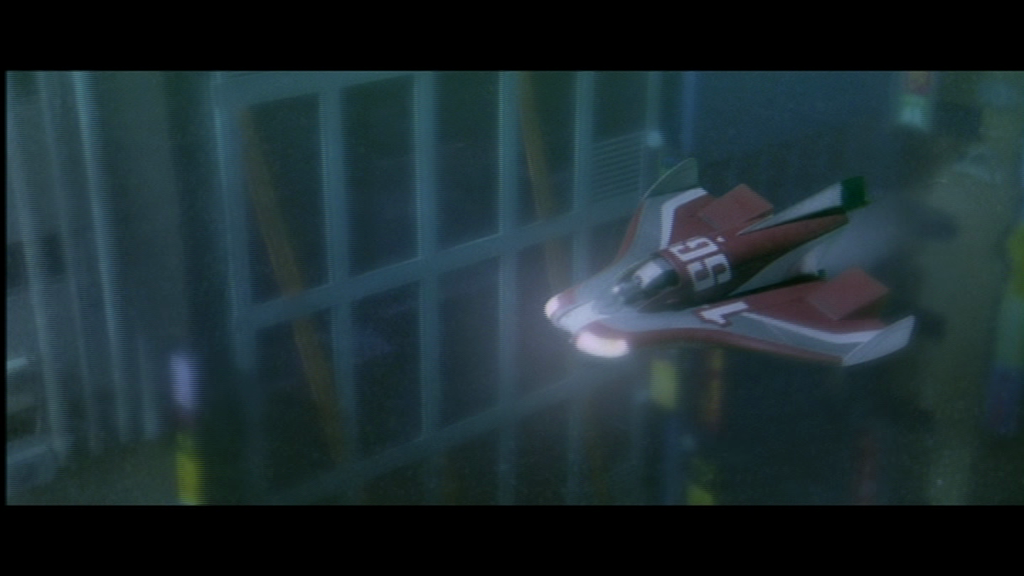
 Things then slow down for a little bit: Dimension Tide is officially named and is launched into orbit from Tanegashima Island Space Center (more bad CGI as it becomes operational up there), and then, we get a lesson about the history and nature of the Meganula from this grizzled professor at G-Grasper headquarters who confirms from the skin sample they took from the corpse that it is what they're dealing with (I severely doubt this is scientifically accurate). During this discussion, they're shown a news bulletin about how Shibuya has become completely flooded, as we're treated to helicopter shots of the area as the reporter tries to explain how this may have happened and that people are frantically trying to get out, causing large traffic jams. The professor tells Tsujimori that this needs to be investigated, with Kudo then piping up and presenting them with a miniature SGS with an infrared camera that they can use to investigate underwater. We're then shown the ongoing evacuation, which include a shot of Jun and his mother running through the crowd and another of a little crying girl getting picked up by her mother, while the G-Graspers arrive and begin investigating the flooded district. While more people are led to dry land via some motorboats (don't they look like they're having a little too much fun for what's currently happening?) and the media tries to figure out what's going on, Kudo's miniature SGS is being used to search underwater. Sending its camera images back to headquarters, everyone there is greeted with the eerie image of dozens of Meganula eggs along the submerged streets. Meanwhile, the Griffon's SGS catches up with Godzilla in the Ogasawara Trench and after his position is transmitted back to G-Grasper headquarters (the shot of him on the video monitor is more bad CGI), we get into the Defense Bureau meeting in Osaka, where Tsujimori proposes her plan to use Dimension Tide against him when he eventually comes ashore on small, uninhabited Kiganjima Island. She argues for its use when the officials question whether it will be 100% effective, ensuring them that it will work. Following that is a little fluff scene where Kudo shows off a new computer program that he came up with in his spare time that checks operating systems fifteen times faster than normal and is characterized by the image of a little nurse that actually goes around and gives each part of the system a checkup (exactly how much spare time does this guy have on his hands?)
Things then slow down for a little bit: Dimension Tide is officially named and is launched into orbit from Tanegashima Island Space Center (more bad CGI as it becomes operational up there), and then, we get a lesson about the history and nature of the Meganula from this grizzled professor at G-Grasper headquarters who confirms from the skin sample they took from the corpse that it is what they're dealing with (I severely doubt this is scientifically accurate). During this discussion, they're shown a news bulletin about how Shibuya has become completely flooded, as we're treated to helicopter shots of the area as the reporter tries to explain how this may have happened and that people are frantically trying to get out, causing large traffic jams. The professor tells Tsujimori that this needs to be investigated, with Kudo then piping up and presenting them with a miniature SGS with an infrared camera that they can use to investigate underwater. We're then shown the ongoing evacuation, which include a shot of Jun and his mother running through the crowd and another of a little crying girl getting picked up by her mother, while the G-Graspers arrive and begin investigating the flooded district. While more people are led to dry land via some motorboats (don't they look like they're having a little too much fun for what's currently happening?) and the media tries to figure out what's going on, Kudo's miniature SGS is being used to search underwater. Sending its camera images back to headquarters, everyone there is greeted with the eerie image of dozens of Meganula eggs along the submerged streets. Meanwhile, the Griffon's SGS catches up with Godzilla in the Ogasawara Trench and after his position is transmitted back to G-Grasper headquarters (the shot of him on the video monitor is more bad CGI), we get into the Defense Bureau meeting in Osaka, where Tsujimori proposes her plan to use Dimension Tide against him when he eventually comes ashore on small, uninhabited Kiganjima Island. She argues for its use when the officials question whether it will be 100% effective, ensuring them that it will work. Following that is a little fluff scene where Kudo shows off a new computer program that he came up with in his spare time that checks operating systems fifteen times faster than normal and is characterized by the image of a little nurse that actually goes around and gives each part of the system a checkup (exactly how much spare time does this guy have on his hands?)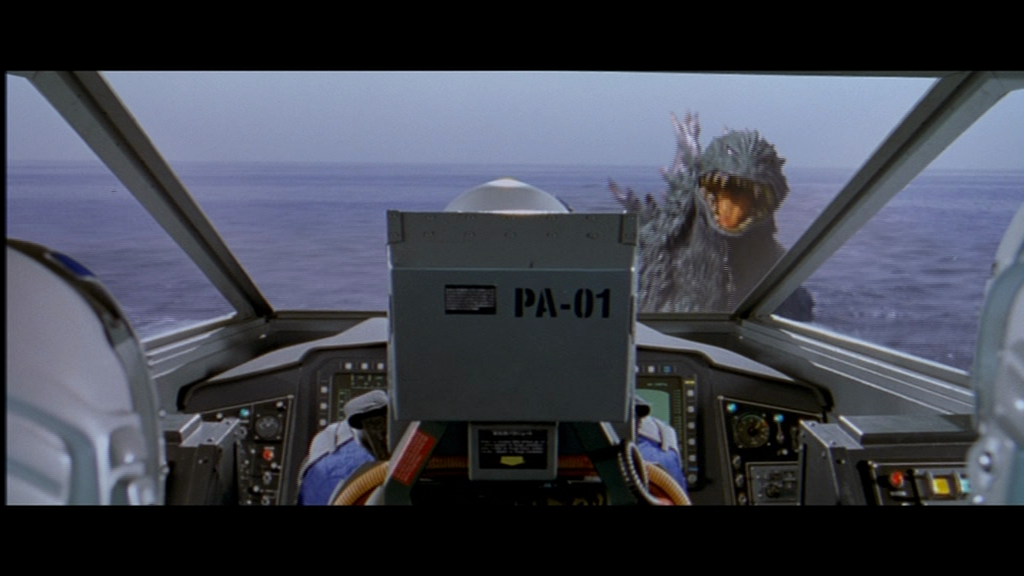



 Soon, it's time to launch said attack against Godzilla. Circling around Kiganjima Island, three fighter jets fly directly above the ocean surface, with two of them firing charges descend down into the depths and hit Godzilla on his left side as he swims (more bad CGI). Three more charges are fired into the water by another squadron and all hit their mark. Godzilla then comes to the surface with a roar and that's when the Griffon shows up. The ship flies right past his face in order to get his attention before flying to his right side and hitting him with their photon guns to ensure it. Godzilla then turns his head and roars at them before charging up and firing his atomic blast. The Griffon manages to dodge it but three of the jets aren't so lucky. Another jet flies through the dissipating explosion and fires two missiles at Godzilla but he ignores those shots, intent on going after the Griffon, which is luring him to the island. Meanwhile, in Shibuya, a small military unit is using boats to reach the spot where the Meganula eggs are, planning to use explosives to destroy them. But, as they come around a corner, they see that they're much to late. All of the eggs have hatched and dozens upon dozens of Meganulons are hanging off the building as they prepare to molt and become Meganulas. Upon seeing this, the sergeant in one boat orders the insects fired upon but, while they manage to shoot down a few, they're easily overwhelmed, with more bugs managing to succeed in molting and beginning to fly, with two of them flying past one of the boats and knocking one soldier into the water. After that, all of the remaining bugs fly off from the side of the building and take off into the sky in a big swarm, while the soldiers can do nothing but watch. Back at the island, the Griffon is still managing to lure Godzilla to shore. Now that he's almost there, Tsujimori orders Dimension Tide to be put on standby. The satellite's system is put on standby and then in operational mode, which engages the weapon's entire barrel and begins the countdown to launch starting at 300 seconds (five minutes). Godzilla then comes ashore on the island, with the Griffon hovering not too far in front of him in order to keep his attention. But, that's when the Meganula swarm shows up, flying past the Griffon towards Godzilla. Tsujimori orders a code alert and tells headquarters what's going on. With Dimension Tide ready to fire, they attempt to lock onto Godzilla but the Meganulas make it impossible for the system to do so by swarming directly within the weapon's range. Sugiura tells the operator to forget about the dragonflies and attempt to fire the weapon anyway.
Soon, it's time to launch said attack against Godzilla. Circling around Kiganjima Island, three fighter jets fly directly above the ocean surface, with two of them firing charges descend down into the depths and hit Godzilla on his left side as he swims (more bad CGI). Three more charges are fired into the water by another squadron and all hit their mark. Godzilla then comes to the surface with a roar and that's when the Griffon shows up. The ship flies right past his face in order to get his attention before flying to his right side and hitting him with their photon guns to ensure it. Godzilla then turns his head and roars at them before charging up and firing his atomic blast. The Griffon manages to dodge it but three of the jets aren't so lucky. Another jet flies through the dissipating explosion and fires two missiles at Godzilla but he ignores those shots, intent on going after the Griffon, which is luring him to the island. Meanwhile, in Shibuya, a small military unit is using boats to reach the spot where the Meganula eggs are, planning to use explosives to destroy them. But, as they come around a corner, they see that they're much to late. All of the eggs have hatched and dozens upon dozens of Meganulons are hanging off the building as they prepare to molt and become Meganulas. Upon seeing this, the sergeant in one boat orders the insects fired upon but, while they manage to shoot down a few, they're easily overwhelmed, with more bugs managing to succeed in molting and beginning to fly, with two of them flying past one of the boats and knocking one soldier into the water. After that, all of the remaining bugs fly off from the side of the building and take off into the sky in a big swarm, while the soldiers can do nothing but watch. Back at the island, the Griffon is still managing to lure Godzilla to shore. Now that he's almost there, Tsujimori orders Dimension Tide to be put on standby. The satellite's system is put on standby and then in operational mode, which engages the weapon's entire barrel and begins the countdown to launch starting at 300 seconds (five minutes). Godzilla then comes ashore on the island, with the Griffon hovering not too far in front of him in order to keep his attention. But, that's when the Meganula swarm shows up, flying past the Griffon towards Godzilla. Tsujimori orders a code alert and tells headquarters what's going on. With Dimension Tide ready to fire, they attempt to lock onto Godzilla but the Meganulas make it impossible for the system to do so by swarming directly within the weapon's range. Sugiura tells the operator to forget about the dragonflies and attempt to fire the weapon anyway.


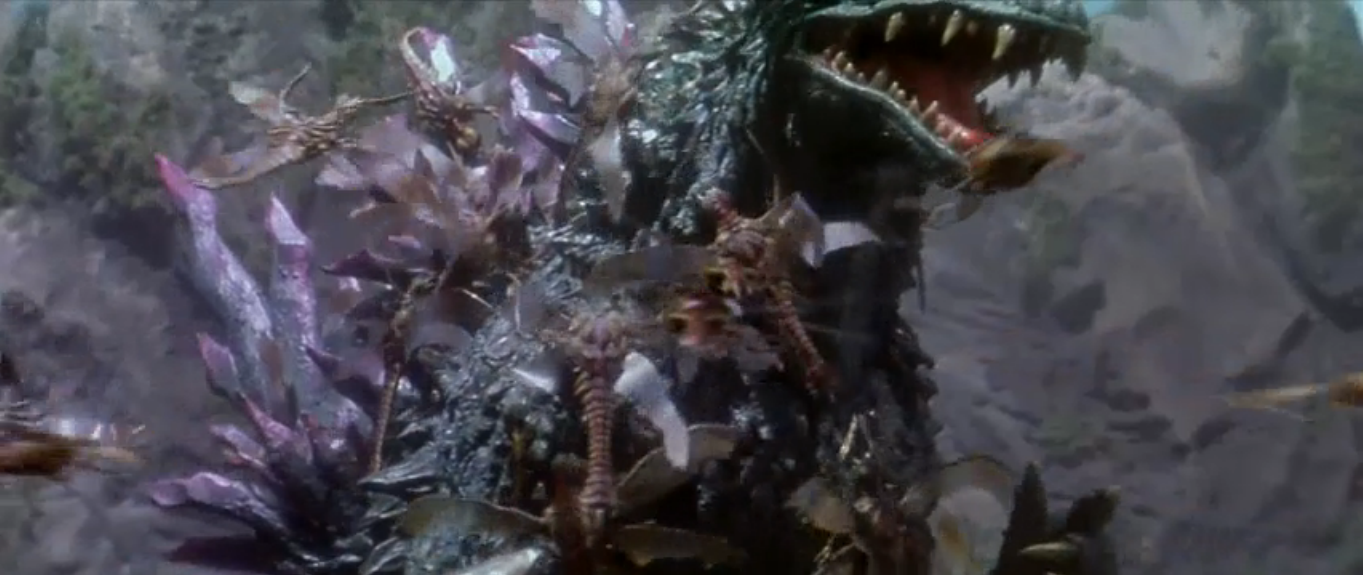
 As the Meganulas swarm above him, Godzilla looks up at them completely perplexed, not sure what to make of what's going on. He then fires his atomic blast and manages to take out a number of the dragonflies but not nearly enough. What's more, now that they know from his atomic blast that he's an energy source, the Meganulas fly directly at Godzilla and surround him, causing him to look around and growl frantically. Three land on his head and attempt to steal his energy and while he manages to shake them off, this prompts the others to begin doing so. They get on every part of his body and suck the energy up through their bodies like mosquitoes sucking blood, infuriating Godzilla and prompting him to swipe at them futilely. He manages to crunch one in his mouth and pull off one that's on his chest, throw it to the ground, and stomp it. He then swings his tail and slams it against a rock-face next to him in an attempt to smash those there and then, he slams the entire side of his body onto the rocks before stomping on the bugs he managed to knock off. He slams himself against the rocks a couple of more times and then, noticing those that hovering around the tip of his tail in an attempt to land back on it, he swirls it a few times before whipping and sending some of those bugs flying before using it to smash those that are on his back and spines. Powering up his atomic blast enables him to fry those on his spines he couldn't reach and follows that up by zapping a good number of those above him, causing their flaming bodies to crash to the ground. With the air now not as crowded as it was before, they decide to fire Dimension Tide. They manage to lock onto Godzilla and fire the miniature black hole at him from space. The black hole catches Godzilla's attention as it enters Earth's atmosphere and begins sucking everything up towards it, including the remaining Meganulas. The black hole hits the island and a huge, blinding explosion fills the air. It quickly dissipates and vanishes, and as Dimension Tide enters cooling mode, everyone at HQ is anxious to see if it worked. The dust and energy completely clear, revealing a large crater but no sign of Godzilla. The Griffon surveys the scene and at first finds nothing more than a bunch of dead Meganulas on the ground. However, their hopes are then dashed when Godzilla erupts out of some rubble right off to the side of the crater. Once everyone at HQ realizes that he's still alive, Sugiura demands that they fire again but Dr. Yoshizawa tells him that it'll be an hour before Dimension Tide is ready to fire again. Godzilla watches as the still-living Meganulas fly off towards the horizon (if you look closely, you can see one fall dead into the water) and he decides to head back out to sea as well. The Griffon follows him for a little bit and, upon hearing the craft, Godzilla stops and turns to look directly at it, appearing to lock eyes with Tsujimori herself. After groaning at the aircraft, Godzilla turns back around and leaves the island, while all Tsujimori and her crew can do is watch.
As the Meganulas swarm above him, Godzilla looks up at them completely perplexed, not sure what to make of what's going on. He then fires his atomic blast and manages to take out a number of the dragonflies but not nearly enough. What's more, now that they know from his atomic blast that he's an energy source, the Meganulas fly directly at Godzilla and surround him, causing him to look around and growl frantically. Three land on his head and attempt to steal his energy and while he manages to shake them off, this prompts the others to begin doing so. They get on every part of his body and suck the energy up through their bodies like mosquitoes sucking blood, infuriating Godzilla and prompting him to swipe at them futilely. He manages to crunch one in his mouth and pull off one that's on his chest, throw it to the ground, and stomp it. He then swings his tail and slams it against a rock-face next to him in an attempt to smash those there and then, he slams the entire side of his body onto the rocks before stomping on the bugs he managed to knock off. He slams himself against the rocks a couple of more times and then, noticing those that hovering around the tip of his tail in an attempt to land back on it, he swirls it a few times before whipping and sending some of those bugs flying before using it to smash those that are on his back and spines. Powering up his atomic blast enables him to fry those on his spines he couldn't reach and follows that up by zapping a good number of those above him, causing their flaming bodies to crash to the ground. With the air now not as crowded as it was before, they decide to fire Dimension Tide. They manage to lock onto Godzilla and fire the miniature black hole at him from space. The black hole catches Godzilla's attention as it enters Earth's atmosphere and begins sucking everything up towards it, including the remaining Meganulas. The black hole hits the island and a huge, blinding explosion fills the air. It quickly dissipates and vanishes, and as Dimension Tide enters cooling mode, everyone at HQ is anxious to see if it worked. The dust and energy completely clear, revealing a large crater but no sign of Godzilla. The Griffon surveys the scene and at first finds nothing more than a bunch of dead Meganulas on the ground. However, their hopes are then dashed when Godzilla erupts out of some rubble right off to the side of the crater. Once everyone at HQ realizes that he's still alive, Sugiura demands that they fire again but Dr. Yoshizawa tells him that it'll be an hour before Dimension Tide is ready to fire again. Godzilla watches as the still-living Meganulas fly off towards the horizon (if you look closely, you can see one fall dead into the water) and he decides to head back out to sea as well. The Griffon follows him for a little bit and, upon hearing the craft, Godzilla stops and turns to look directly at it, appearing to lock eyes with Tsujimori herself. After groaning at the aircraft, Godzilla turns back around and leaves the island, while all Tsujimori and her crew can do is watch.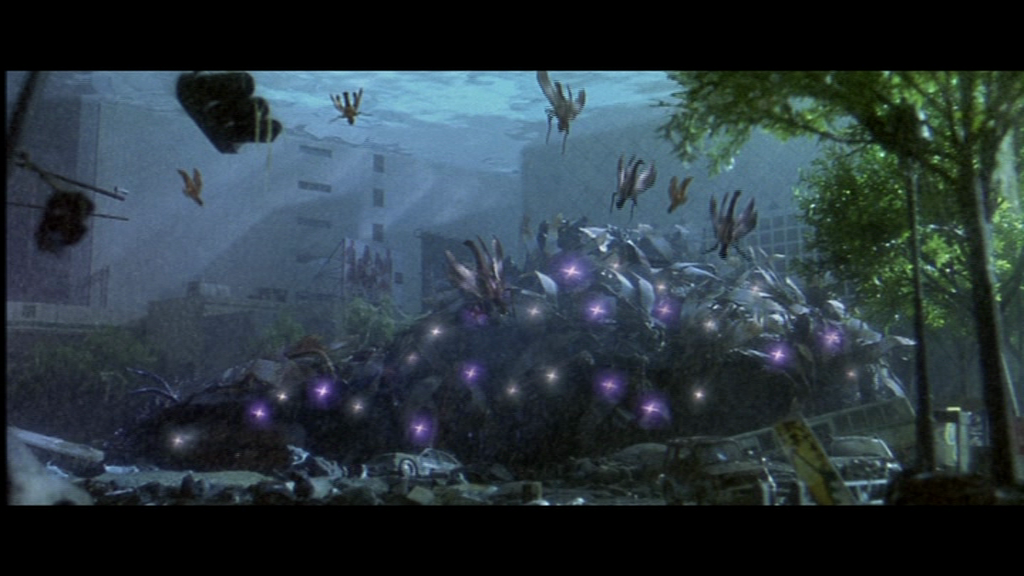
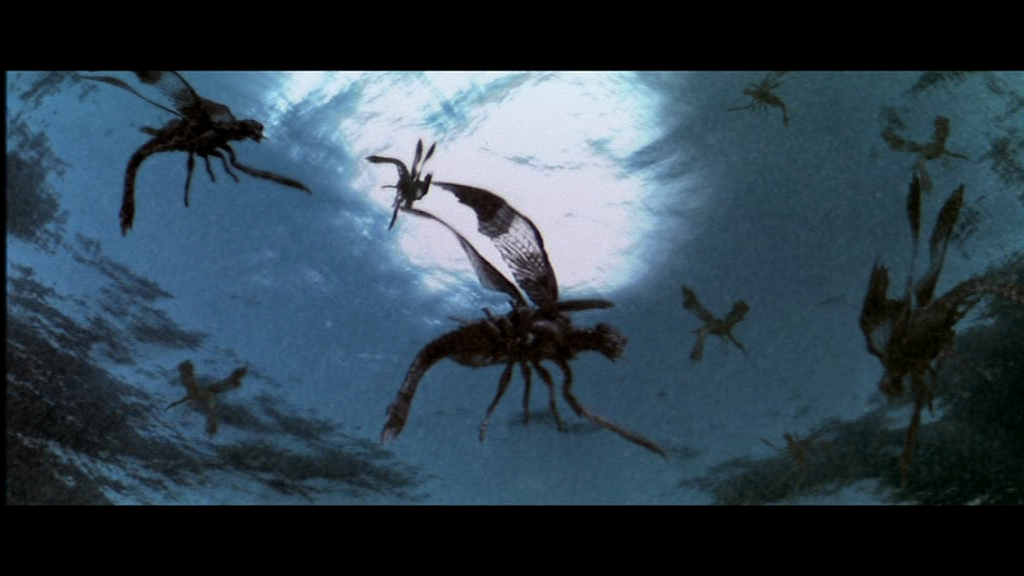



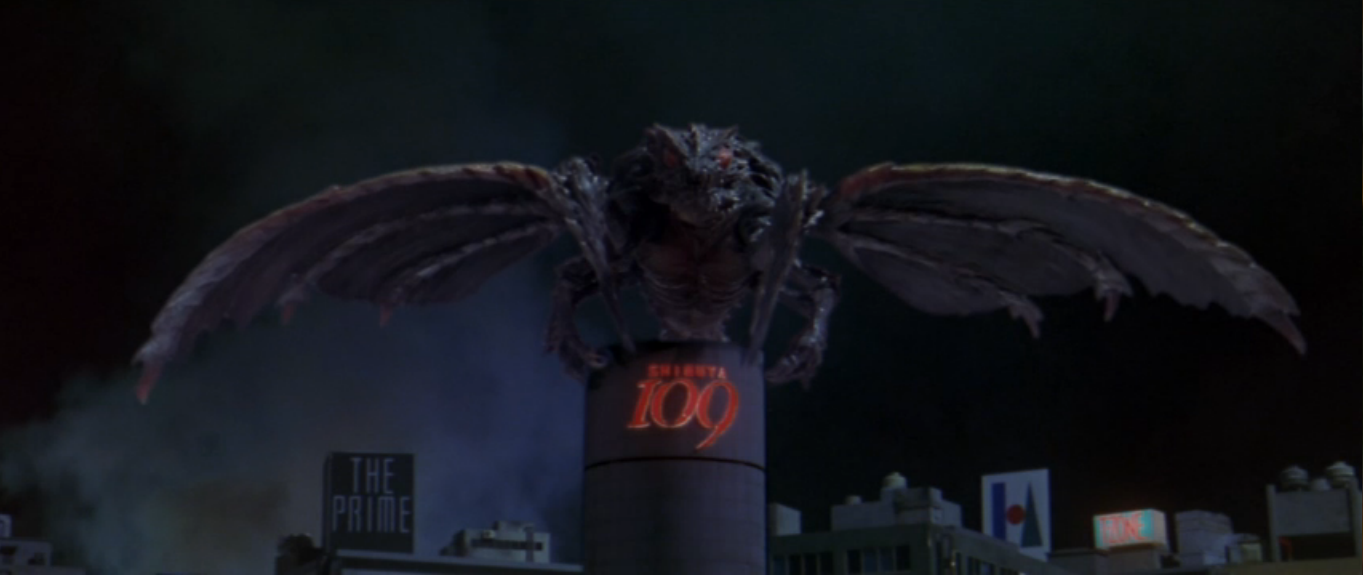 The Meganulas arrive back in Tokyo and descend straight down into the water in Shibuya, the bottom of which now houses an enormous Meganulon. Swimming down towards it, the Meganulas use their stingers to inject the energy they took from Godzilla into it, causing the enormous creature to stir as a result. Once their purpose is completed, the Meganulas all die and their lifeless bodies float up to the surface of the water. After that comes a brief squabble between Tsujimori and Kudo about whose fault it was that Dimension Tide failed but Yoshizawa manages to defuse the fight by ensuring that it's been fine-tuned enough to where it will work next time. Sugiura then orders every inch of the distance from Kiganjima Island to Tokyo searched, saying it's possible that Godzilla may be heading for Tokyo. Back at the ongoing crisis in Shibuya, Kudo gives the military there another miniature SGS to replace the first one, which recently malfunctioned for some reason. While he's examining the remains of the first unit, a couple of soldiers that some of their equipment has been acting up recently, including the radio, making Kudo theorize if there's something magnetic beneath the water. At that very moment, deep within the flooded district, the enormous Meganulon is molting into its adult form, with the newly formed monster slowly pulling itself out of its empty shell. As everyone nearby watches, Megaguirus makes her first appearance by exploding out of the water and then hovering just a few feet above it. She hovers around in a circle, scanning her environment, while one of the soldiers frantically tries to radio headquarters about her appearance. Megaguirus looks at them and lets out her high-frequency screech for the first time before demonstrating her power by flying towards a building and cutting its entire top section off with her super-sharp wings. She flies above the buildings, causing more destruction, and then lands on top of the Shiesta 109 building. While everyone continues watching her, Megaguirus begins violently flapping her wings, sending out a piercing supersonic noise that forces everyone to clamp their hands over their ears, as the soldiers who were in the shallows run to shore to retreat. Megaguirus then zooms off of the building, which is destroyed from top to bottom by her supersonic waves, and sends more supersonic waves throughout her surroundings, causing everything around her to explode and shatter, as she flies directly above the flooded street. Everyone retreats while Megaguirus continues her destruction but they don't get far because she zooms over the buildings next to them, shattering them to pieces and sending deadly debris flying everywhere. Kudo runs to his car while the soldiers behind him fall victim to the debris but his vehicle is immediately smashed by a big piece of concrete. With nowhere to run, he hunkers down amongst the demolition around and in a cut, he wakes up in bed, alive but with a fractured right arm. The scientist that we saw earlier then identifies the monster as Megaguirus, the queen bee of the Meganulas, and says that her nature is to attack anything she sees to expand her territory. During this discussion, Tsujimori is informed that the SGS has spotted Godzilla, and when she heads to the control room, she learns that Godzilla is just three miles off Hachijojima and heading straight for Tokyo, just as Sugiura felt he would.
The Meganulas arrive back in Tokyo and descend straight down into the water in Shibuya, the bottom of which now houses an enormous Meganulon. Swimming down towards it, the Meganulas use their stingers to inject the energy they took from Godzilla into it, causing the enormous creature to stir as a result. Once their purpose is completed, the Meganulas all die and their lifeless bodies float up to the surface of the water. After that comes a brief squabble between Tsujimori and Kudo about whose fault it was that Dimension Tide failed but Yoshizawa manages to defuse the fight by ensuring that it's been fine-tuned enough to where it will work next time. Sugiura then orders every inch of the distance from Kiganjima Island to Tokyo searched, saying it's possible that Godzilla may be heading for Tokyo. Back at the ongoing crisis in Shibuya, Kudo gives the military there another miniature SGS to replace the first one, which recently malfunctioned for some reason. While he's examining the remains of the first unit, a couple of soldiers that some of their equipment has been acting up recently, including the radio, making Kudo theorize if there's something magnetic beneath the water. At that very moment, deep within the flooded district, the enormous Meganulon is molting into its adult form, with the newly formed monster slowly pulling itself out of its empty shell. As everyone nearby watches, Megaguirus makes her first appearance by exploding out of the water and then hovering just a few feet above it. She hovers around in a circle, scanning her environment, while one of the soldiers frantically tries to radio headquarters about her appearance. Megaguirus looks at them and lets out her high-frequency screech for the first time before demonstrating her power by flying towards a building and cutting its entire top section off with her super-sharp wings. She flies above the buildings, causing more destruction, and then lands on top of the Shiesta 109 building. While everyone continues watching her, Megaguirus begins violently flapping her wings, sending out a piercing supersonic noise that forces everyone to clamp their hands over their ears, as the soldiers who were in the shallows run to shore to retreat. Megaguirus then zooms off of the building, which is destroyed from top to bottom by her supersonic waves, and sends more supersonic waves throughout her surroundings, causing everything around her to explode and shatter, as she flies directly above the flooded street. Everyone retreats while Megaguirus continues her destruction but they don't get far because she zooms over the buildings next to them, shattering them to pieces and sending deadly debris flying everywhere. Kudo runs to his car while the soldiers behind him fall victim to the debris but his vehicle is immediately smashed by a big piece of concrete. With nowhere to run, he hunkers down amongst the demolition around and in a cut, he wakes up in bed, alive but with a fractured right arm. The scientist that we saw earlier then identifies the monster as Megaguirus, the queen bee of the Meganulas, and says that her nature is to attack anything she sees to expand her territory. During this discussion, Tsujimori is informed that the SGS has spotted Godzilla, and when she heads to the control room, she learns that Godzilla is just three miles off Hachijojima and heading straight for Tokyo, just as Sugiura felt he would.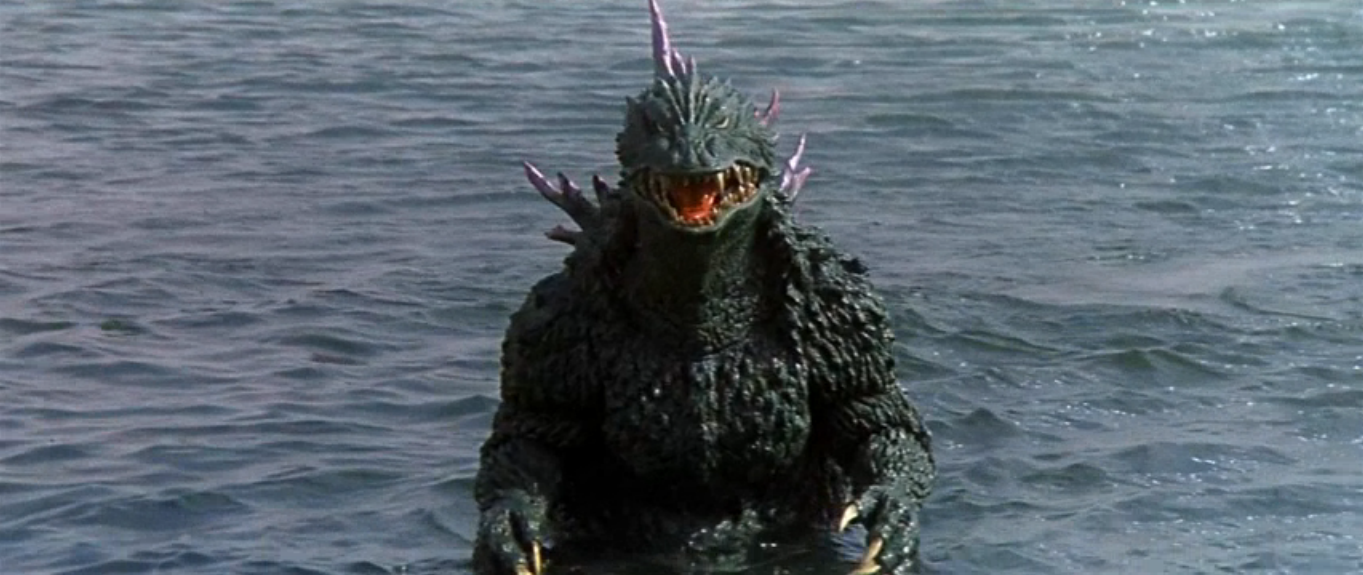
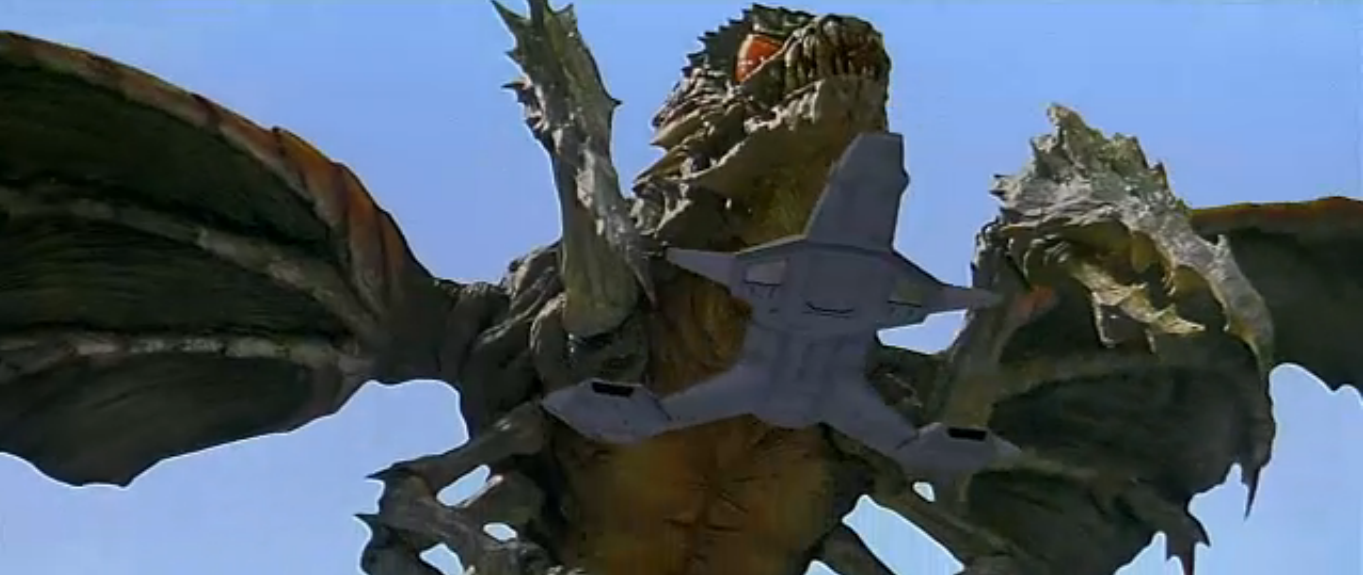
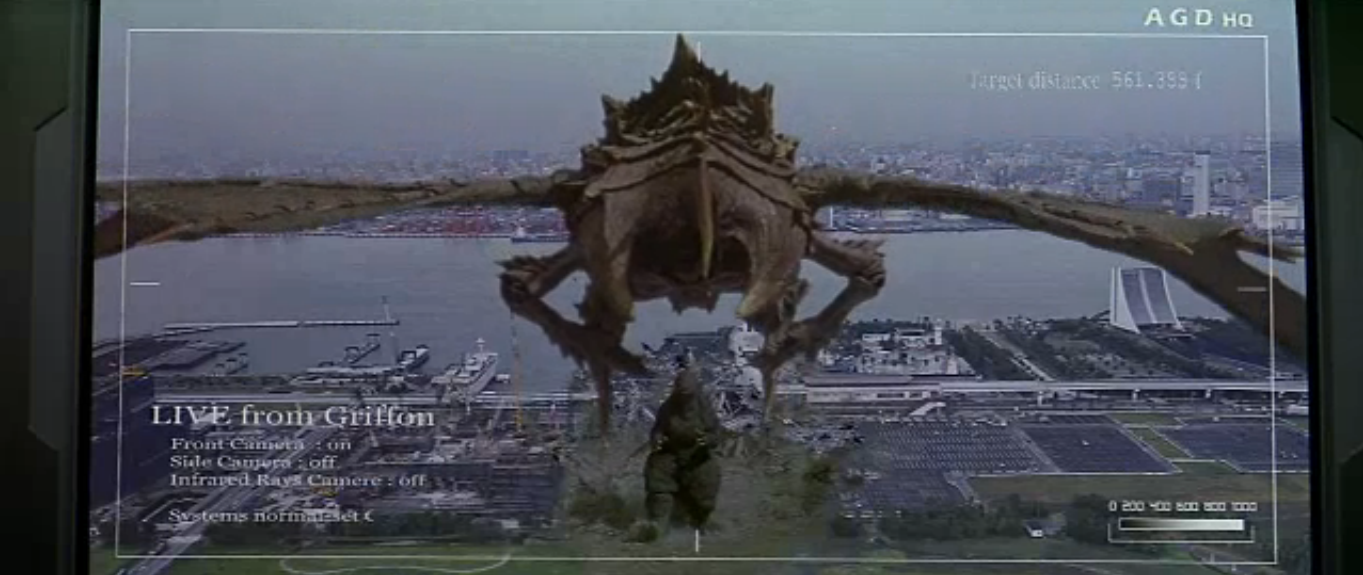

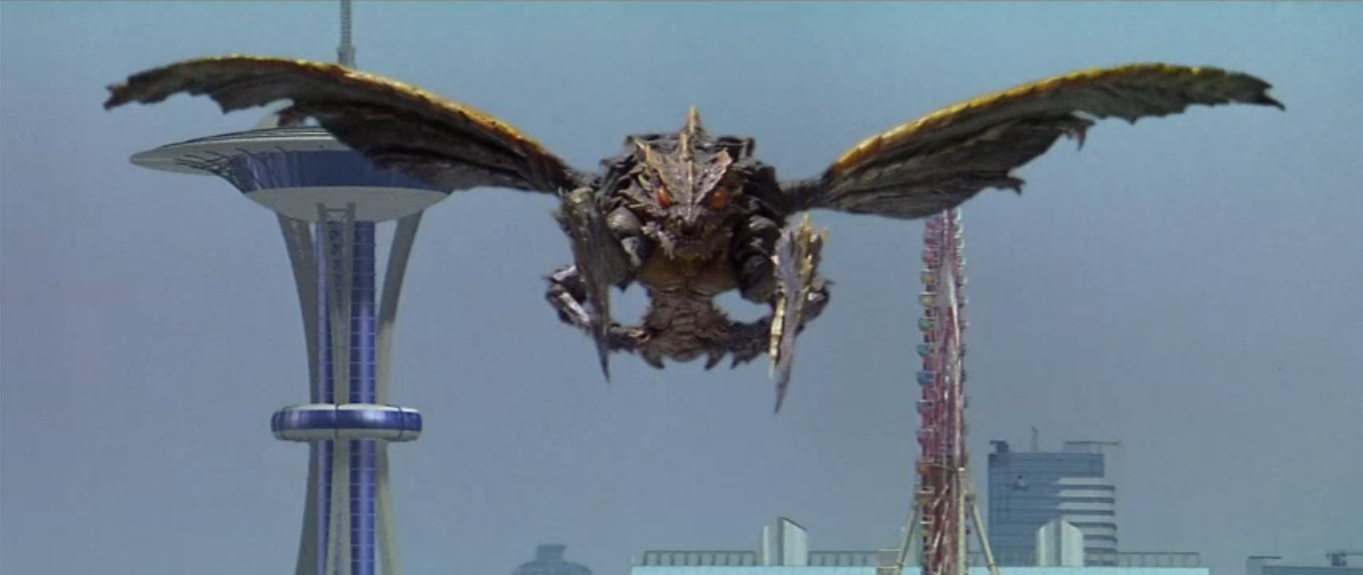
 Following an underwater shot of Godzilla being followed by the SGS, we get the typical Tokyo evacuation scene, with people running around like mad and being escorted to safety by troops. A reporter who's describing the scene to anybody who's watching on TV is forcibly removed from the premises, while one of the G-Graspers (I honestly don't remember which one it is) fends off questions from other reporters, saying that they expect Godzilla to arrive in five hours but tells them that they're not entirely sure where he'll come ashore and that speculation would make the already critical situation worse. In the midst of the ongoing evacuation, which includes the two guys from the water department that were seen earlier, Jun's mother tries to contact her husband on a cellphone but when he doesn't answer, they're forced to go on without him (never once in the film do you see this guy and he's never mentioned again after this, making me wonder if he didn't survive what eventually happened). At headquarters, as they keep their eye on Godzilla via the SGS and hear updates on the evacuation, Tsujimori questions Sugiura as to why Godzilla is heading for Tokyo when there's no nuclear or plasma energy there for him to feed on, but the guy just sits there and calmly smokes a cigarette, never once giving her an answer. When she's told that Godzilla is approaching Odaiba, Tsujimori is forced to give up her interrogation and scramble the Griffon. In a cut, the Griffon heads out to confront Godzilla, with Sugiura ordering them to try to keep him in the port, away from the center of the city. Traveling over the city, they soon reach a section of Tokyo Bay where Godzilla's spines are poking up through the water as he surfaces. Entering the shallows, he stands up, prompting the Griffon to fly within his sights to get his attention. Godzilla complies and begins wading towards them, with Hosono responding by firing the photon guns, hitting him in the side of the face and then in the chest as he comes ashore. Godzilla fires his atomic blast in retaliation, which the Griffon quickly dodges. They have to repeat this maneuver when he fires again and once they fly out of his sight, he enters the city, smashing through a monorail track as he enters the port. But, just when they're about to continue the battle, Godzilla stops and rears up, and a shadow passes over the Griffon's cockpit while craft banks slightly at the same time. Megaguirus has arrived and is hovering over the Griffon while facing off with Godzilla. She then flies over the craft and heads toward Godzilla, who approaches her as well. The two of them then face off for a little bit, walking in a circle while never taking their eyes off each other, when Megaguirus begins the fight by swooping down at Godzilla and knocking him down along with a crane that was behind him. Godzilla slowly gets back to his feet, shaking off his disorientation, but is tagged from behind by Megaguirus and falls back down (she actually barely even touched him) while she flies in front of him. At headquarters, Sugiura orders Dimension Tide to be put on standby, saying that they must take care of both monsters with one shot.
Following an underwater shot of Godzilla being followed by the SGS, we get the typical Tokyo evacuation scene, with people running around like mad and being escorted to safety by troops. A reporter who's describing the scene to anybody who's watching on TV is forcibly removed from the premises, while one of the G-Graspers (I honestly don't remember which one it is) fends off questions from other reporters, saying that they expect Godzilla to arrive in five hours but tells them that they're not entirely sure where he'll come ashore and that speculation would make the already critical situation worse. In the midst of the ongoing evacuation, which includes the two guys from the water department that were seen earlier, Jun's mother tries to contact her husband on a cellphone but when he doesn't answer, they're forced to go on without him (never once in the film do you see this guy and he's never mentioned again after this, making me wonder if he didn't survive what eventually happened). At headquarters, as they keep their eye on Godzilla via the SGS and hear updates on the evacuation, Tsujimori questions Sugiura as to why Godzilla is heading for Tokyo when there's no nuclear or plasma energy there for him to feed on, but the guy just sits there and calmly smokes a cigarette, never once giving her an answer. When she's told that Godzilla is approaching Odaiba, Tsujimori is forced to give up her interrogation and scramble the Griffon. In a cut, the Griffon heads out to confront Godzilla, with Sugiura ordering them to try to keep him in the port, away from the center of the city. Traveling over the city, they soon reach a section of Tokyo Bay where Godzilla's spines are poking up through the water as he surfaces. Entering the shallows, he stands up, prompting the Griffon to fly within his sights to get his attention. Godzilla complies and begins wading towards them, with Hosono responding by firing the photon guns, hitting him in the side of the face and then in the chest as he comes ashore. Godzilla fires his atomic blast in retaliation, which the Griffon quickly dodges. They have to repeat this maneuver when he fires again and once they fly out of his sight, he enters the city, smashing through a monorail track as he enters the port. But, just when they're about to continue the battle, Godzilla stops and rears up, and a shadow passes over the Griffon's cockpit while craft banks slightly at the same time. Megaguirus has arrived and is hovering over the Griffon while facing off with Godzilla. She then flies over the craft and heads toward Godzilla, who approaches her as well. The two of them then face off for a little bit, walking in a circle while never taking their eyes off each other, when Megaguirus begins the fight by swooping down at Godzilla and knocking him down along with a crane that was behind him. Godzilla slowly gets back to his feet, shaking off his disorientation, but is tagged from behind by Megaguirus and falls back down (she actually barely even touched him) while she flies in front of him. At headquarters, Sugiura orders Dimension Tide to be put on standby, saying that they must take care of both monsters with one shot.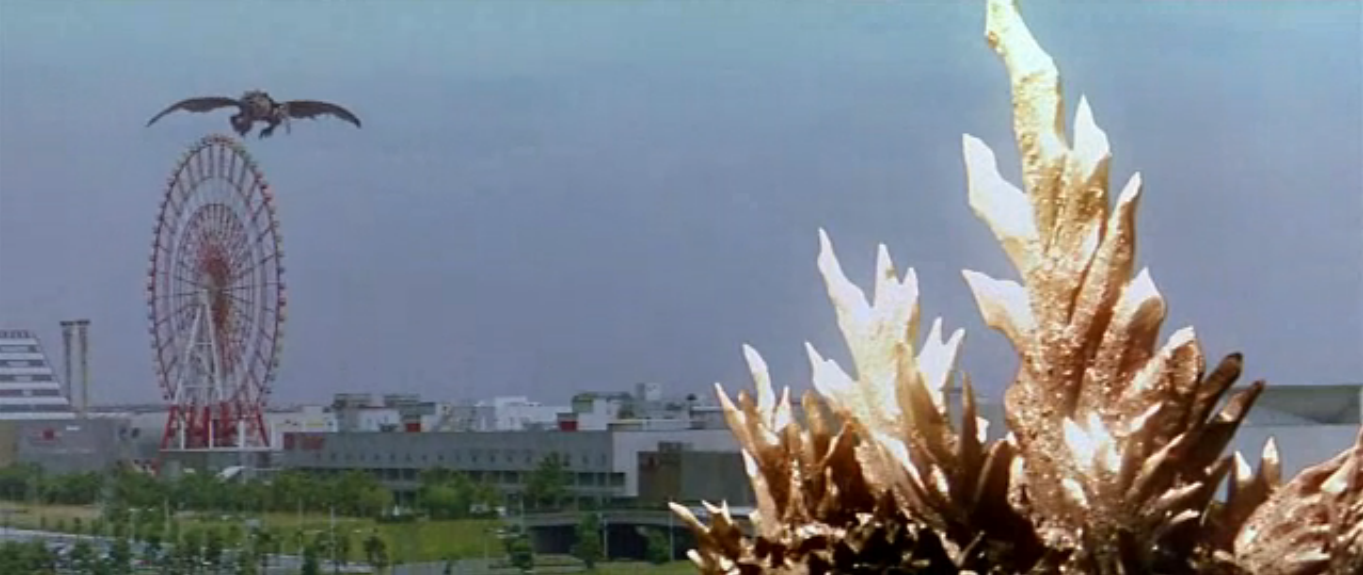
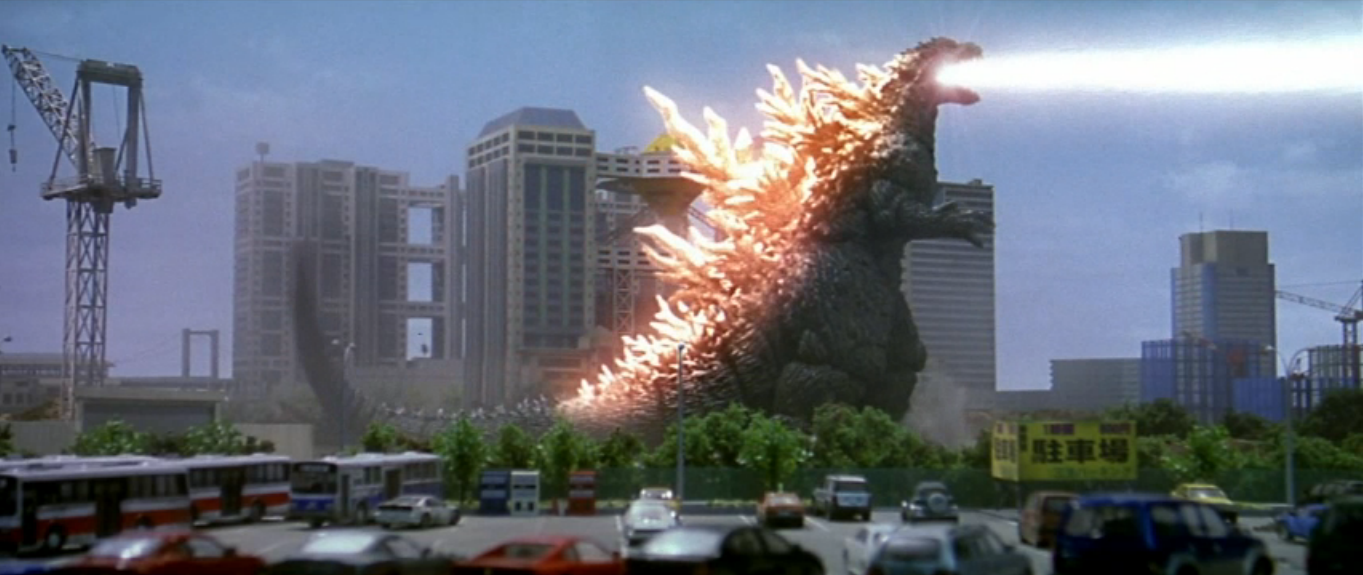

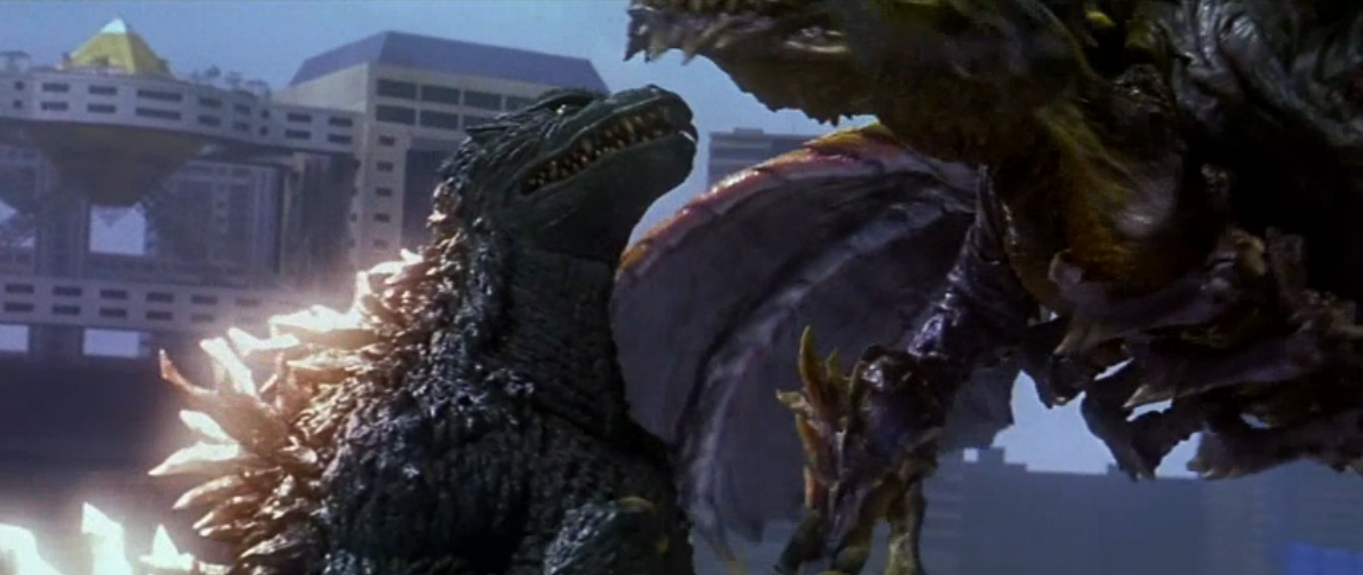
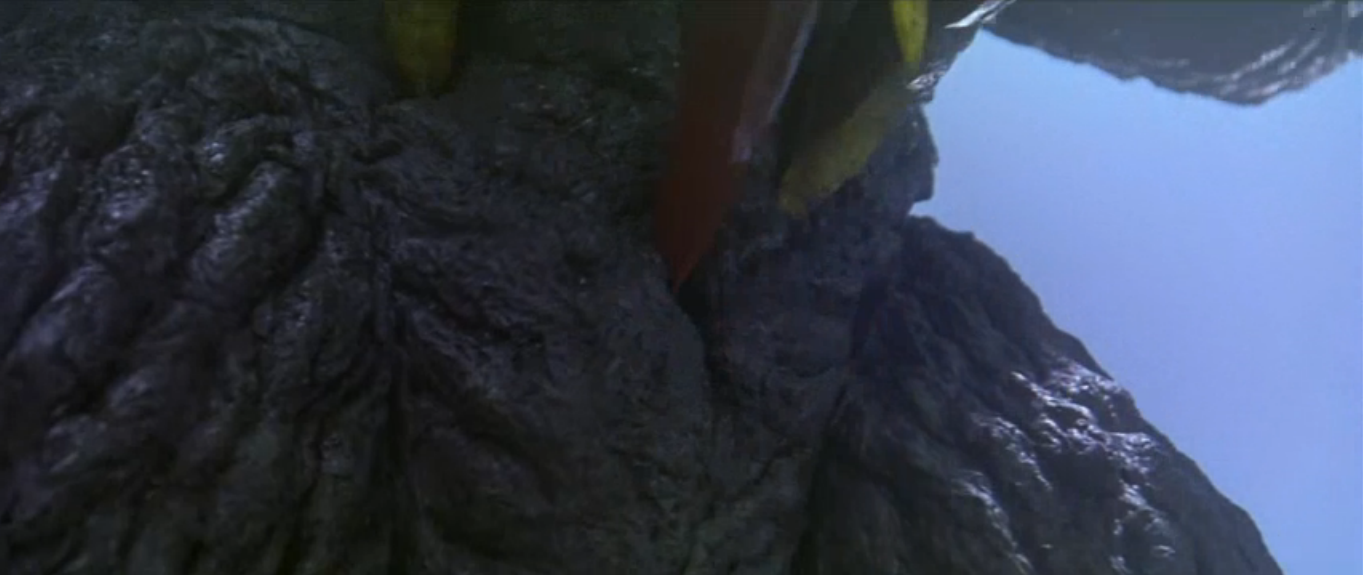

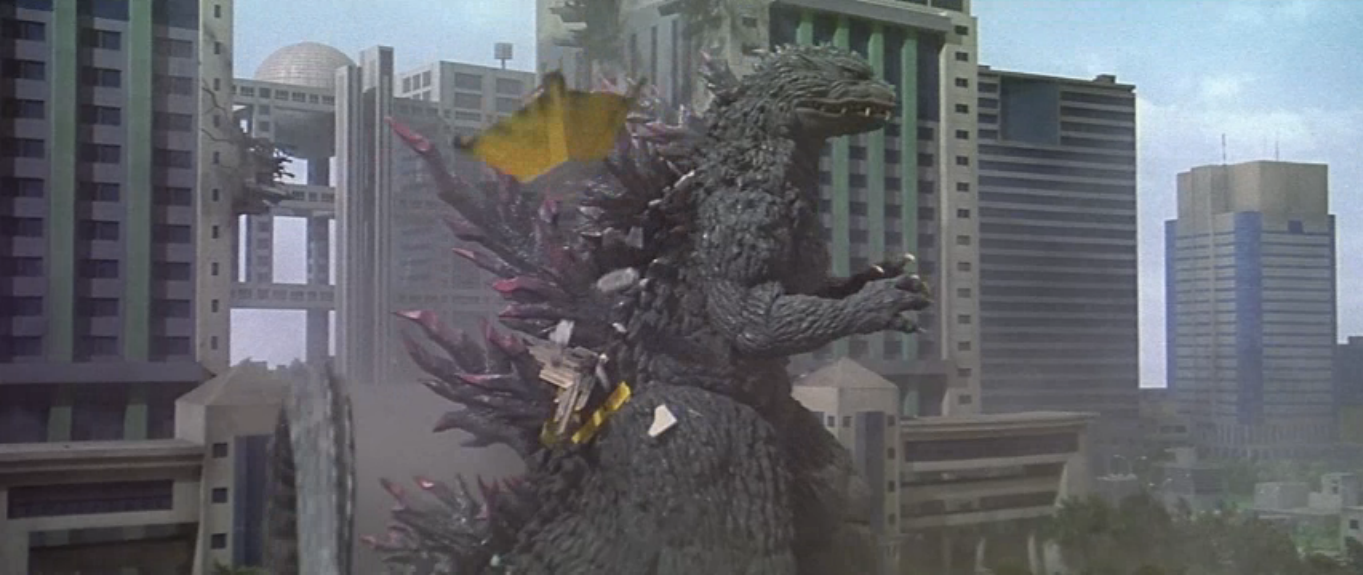
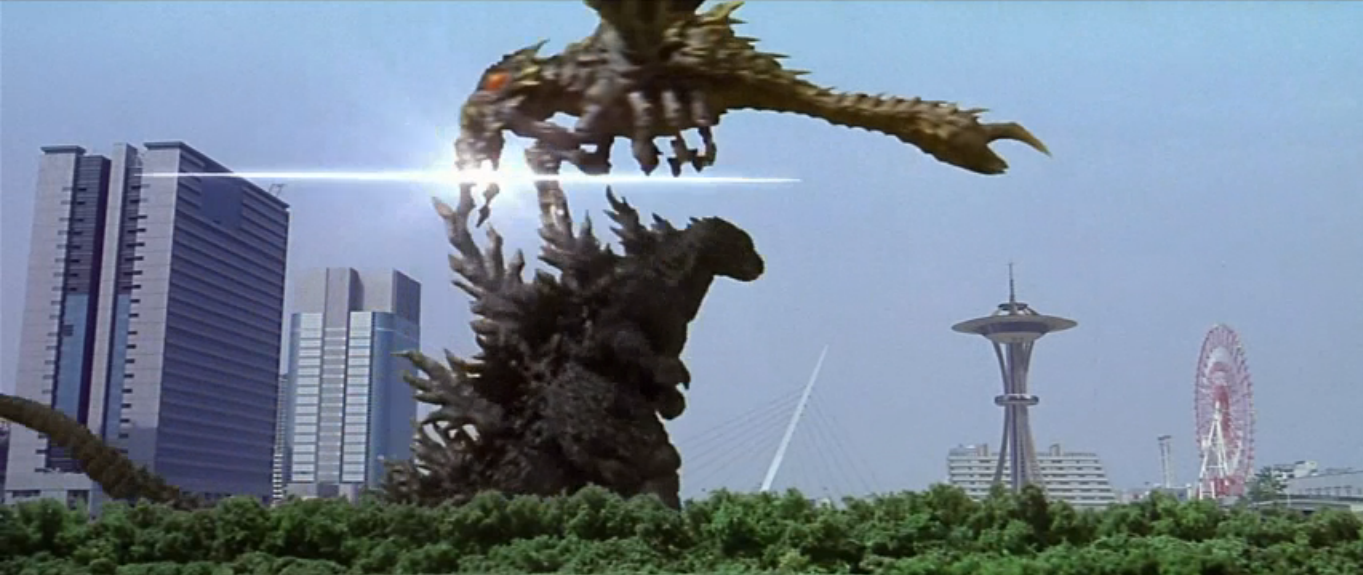
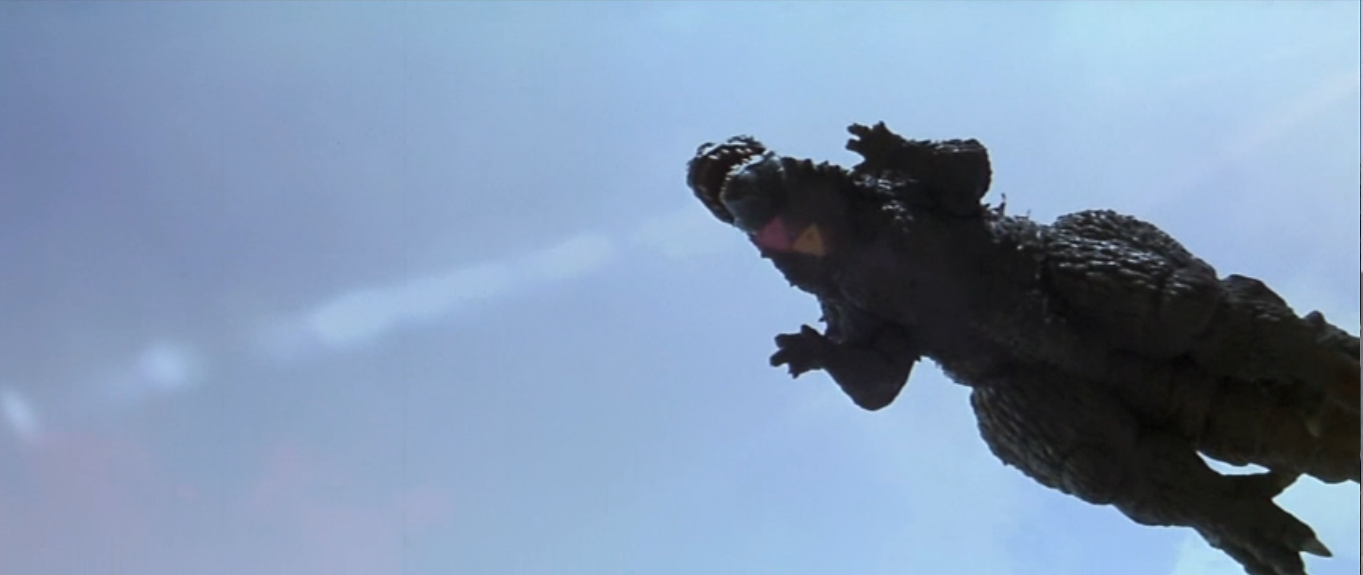
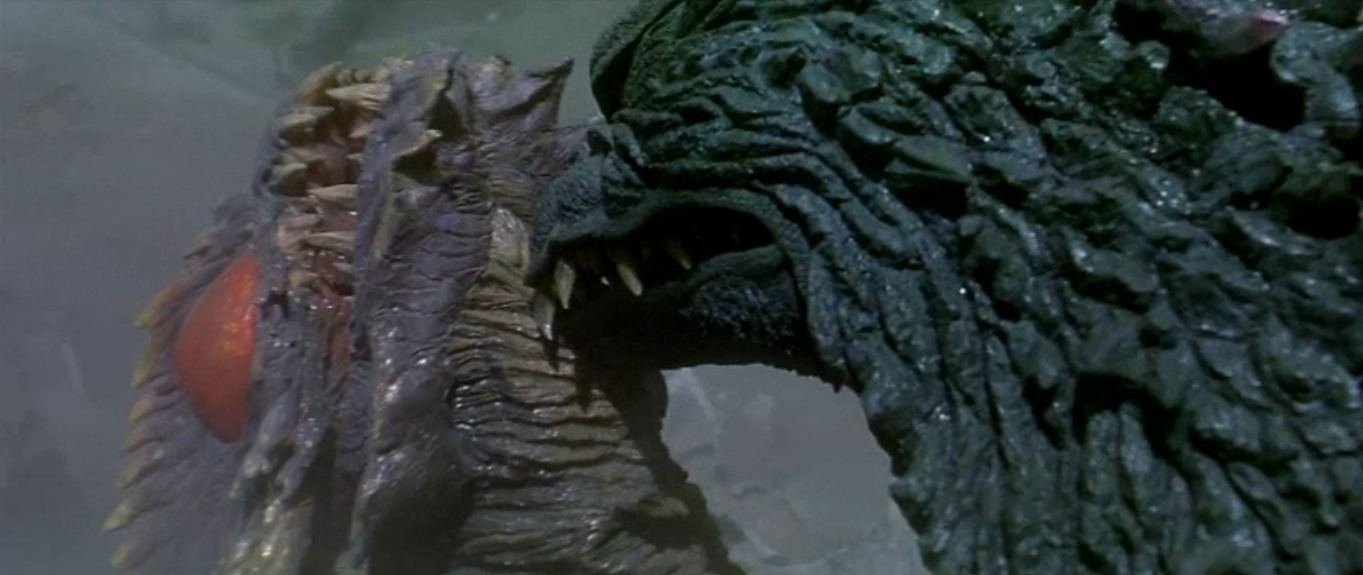

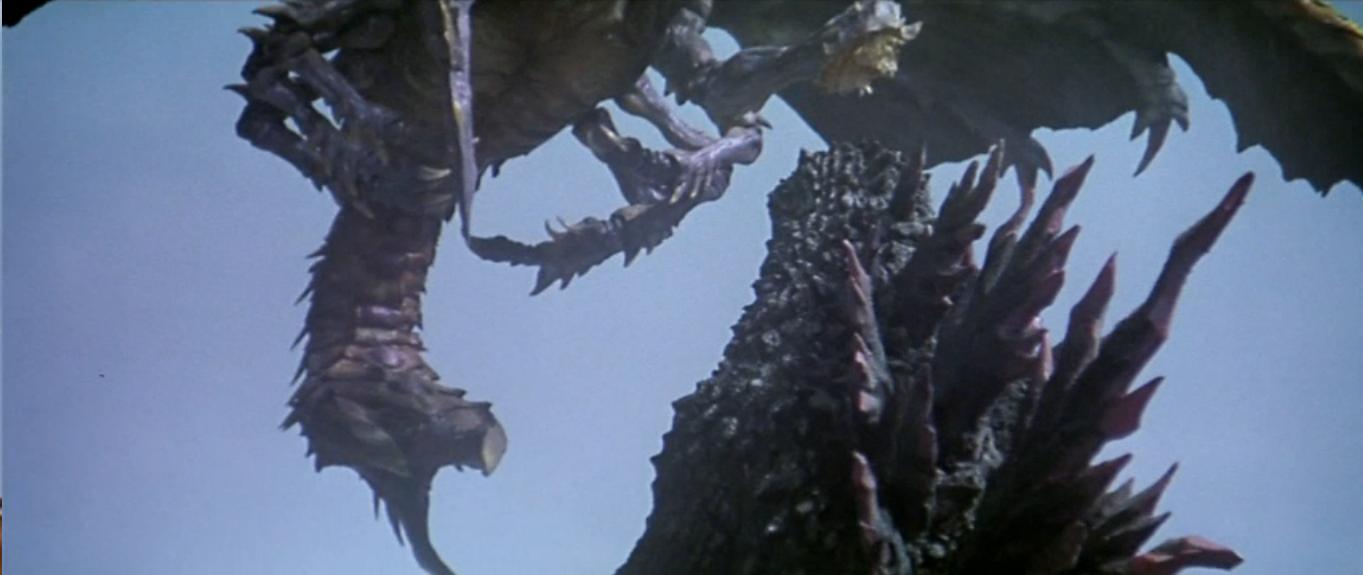
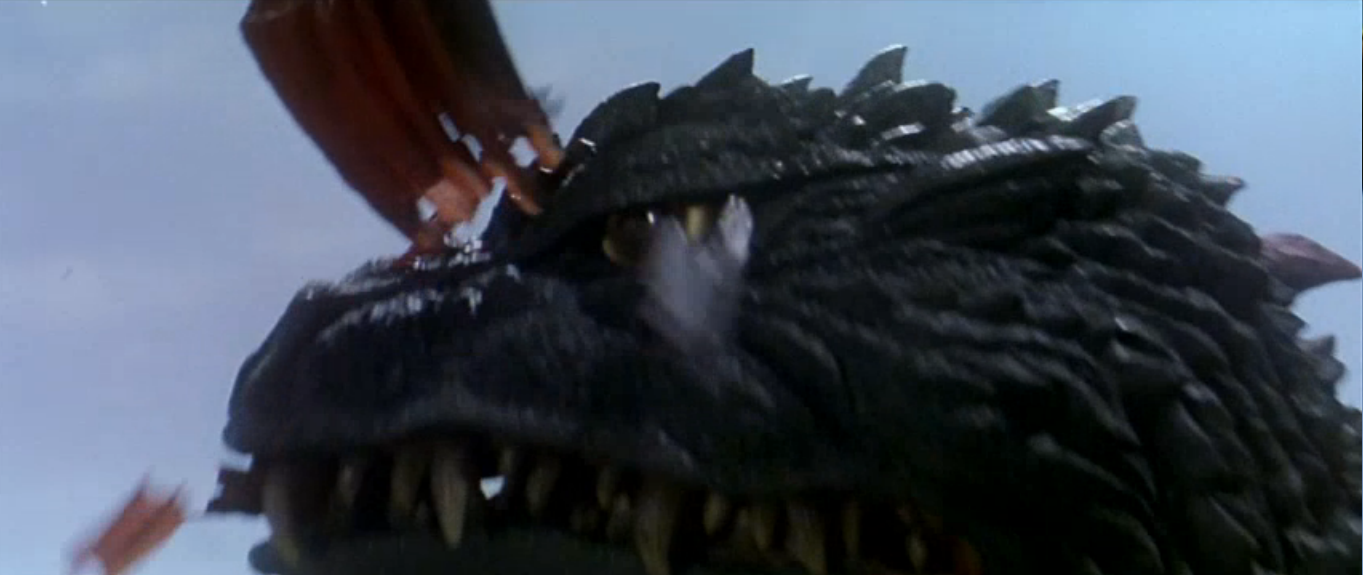

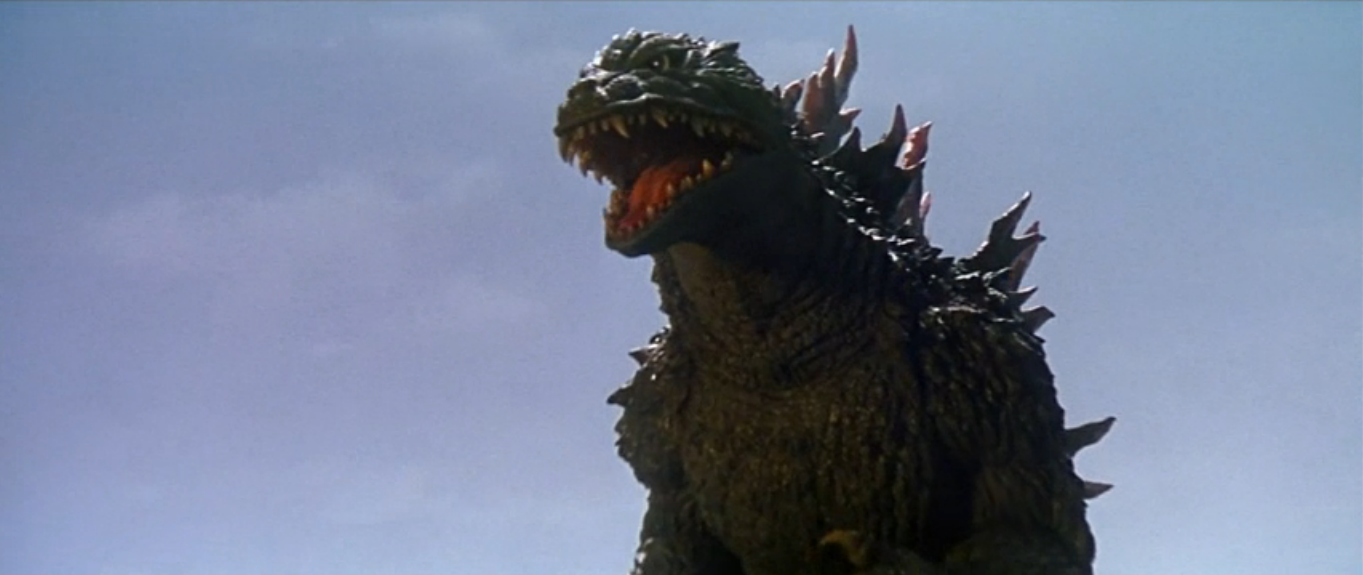 Megaguirus flies over the Griffon as the crew tries to repair its system, while Godzilla gets back up and shakes his head free of disorientation while glaring at Megaguirus, clearly having had enough of this bullshit. She swings back around and heads towards him as he also charges at her. As she swoops at him, Godzilla positions himself to where she scrapes against his largest spine and ducks to avoid her claws. Turning around to face her, Godzilla watches as Megaguirus' left claw falls off. Megaguirus is unfazed by this and rapidly beats her wings again and zooms off. Godzilla looks around, trying to find her, acting perplexed as she drops in behind him. She approaches with her stinger drawn but Godzilla grabs the base of the stinger with his tail and swings Megaguirus to the ground, the force causing her to slide along it and crash into one of the buildings she slammed him in-between earlier. She completely destroys the building with her supersonic waves as she hovers back up top, with Godzilla charging at her again. Back at HQ, with everyone unable to get Dimension Tide working again, Kudo, with his arm still bandaged, shows up to give it a try. As he tries to figure out what the problem is, Megaguirus flies toward Godzilla and sticks him with her stinger again when he charges up his blast. He grabs ahold of her tail and tries to wrench it loose, while Megaguirus retaliates by whacking him in the head with her right claw. She tries to choke him again and then knocks him on his cranium a couple of times before he grabs the claw with his mouth. He then manages to pull the stinger out and slams it down into the ground, effectively clamping her down and making her completely helpless. Godzilla roars at having gained an upper hand and jumps straight up into the air, doing a devastating belly-flop on top of her, slamming her completely down to the ground, as well as crashing her through a small building. Feeling that he's got her trapped, Godzilla tries to reach down and bite her but she uses her agility to zoom out from under him, causing him to end up with a mouthful steel as a consequence. He spits that out and looks around again, trying to find her. At HQ, Kudo uses that nurse program he introduced earlier to fix the program, with the nurse's outfit being replaced by the uniform of a G-Grasper. He then says, "Your move, Kiriko!", indicating that he modeled it on Tsujimori. The tiny major begins fixing the damage to the system but runs into a problem at one point. Back at the battle, Godzilla again charges at Megaguirus, who uses the power she sucked out of him to form an energy ball and fire it at him. At first, it seems like it's fairly weak and doesn't do much to Godzilla, who braces himself against it, but he eventually topples over to his right. Megaguirus then flies at him as he tries to get up, with her stinger ready to suck more energy out of him. First, she knocks him back down when he gets back up and does it again on his side when he gets on his hands and knees. She swings back around to his front as he slowly pulls himself up and, again, points her stinger at him as she flies towards him. She appears to hit her mark and get him in the head... but the camera then quickly pans around to show that Godzilla caught the stinger in his mouth and proceeds to bite the tip of it off. Realizing she's made a fatal mistake, Megaguirus tries to fly up away from Godzilla but he manages to finally score a direct hit with his atomic blast. The top half of Megaguirus' body is engulfed in flames but, as she drops to the ground, Godzilla blasts her again, setting her completely ablaze. She lets out one last chiming moan as she drops to the ground and exploding, with Godzilla finally able to roar in triumph.
Megaguirus flies over the Griffon as the crew tries to repair its system, while Godzilla gets back up and shakes his head free of disorientation while glaring at Megaguirus, clearly having had enough of this bullshit. She swings back around and heads towards him as he also charges at her. As she swoops at him, Godzilla positions himself to where she scrapes against his largest spine and ducks to avoid her claws. Turning around to face her, Godzilla watches as Megaguirus' left claw falls off. Megaguirus is unfazed by this and rapidly beats her wings again and zooms off. Godzilla looks around, trying to find her, acting perplexed as she drops in behind him. She approaches with her stinger drawn but Godzilla grabs the base of the stinger with his tail and swings Megaguirus to the ground, the force causing her to slide along it and crash into one of the buildings she slammed him in-between earlier. She completely destroys the building with her supersonic waves as she hovers back up top, with Godzilla charging at her again. Back at HQ, with everyone unable to get Dimension Tide working again, Kudo, with his arm still bandaged, shows up to give it a try. As he tries to figure out what the problem is, Megaguirus flies toward Godzilla and sticks him with her stinger again when he charges up his blast. He grabs ahold of her tail and tries to wrench it loose, while Megaguirus retaliates by whacking him in the head with her right claw. She tries to choke him again and then knocks him on his cranium a couple of times before he grabs the claw with his mouth. He then manages to pull the stinger out and slams it down into the ground, effectively clamping her down and making her completely helpless. Godzilla roars at having gained an upper hand and jumps straight up into the air, doing a devastating belly-flop on top of her, slamming her completely down to the ground, as well as crashing her through a small building. Feeling that he's got her trapped, Godzilla tries to reach down and bite her but she uses her agility to zoom out from under him, causing him to end up with a mouthful steel as a consequence. He spits that out and looks around again, trying to find her. At HQ, Kudo uses that nurse program he introduced earlier to fix the program, with the nurse's outfit being replaced by the uniform of a G-Grasper. He then says, "Your move, Kiriko!", indicating that he modeled it on Tsujimori. The tiny major begins fixing the damage to the system but runs into a problem at one point. Back at the battle, Godzilla again charges at Megaguirus, who uses the power she sucked out of him to form an energy ball and fire it at him. At first, it seems like it's fairly weak and doesn't do much to Godzilla, who braces himself against it, but he eventually topples over to his right. Megaguirus then flies at him as he tries to get up, with her stinger ready to suck more energy out of him. First, she knocks him back down when he gets back up and does it again on his side when he gets on his hands and knees. She swings back around to his front as he slowly pulls himself up and, again, points her stinger at him as she flies towards him. She appears to hit her mark and get him in the head... but the camera then quickly pans around to show that Godzilla caught the stinger in his mouth and proceeds to bite the tip of it off. Realizing she's made a fatal mistake, Megaguirus tries to fly up away from Godzilla but he manages to finally score a direct hit with his atomic blast. The top half of Megaguirus' body is engulfed in flames but, as she drops to the ground, Godzilla blasts her again, setting her completely ablaze. She lets out one last chiming moan as she drops to the ground and exploding, with Godzilla finally able to roar in triumph. 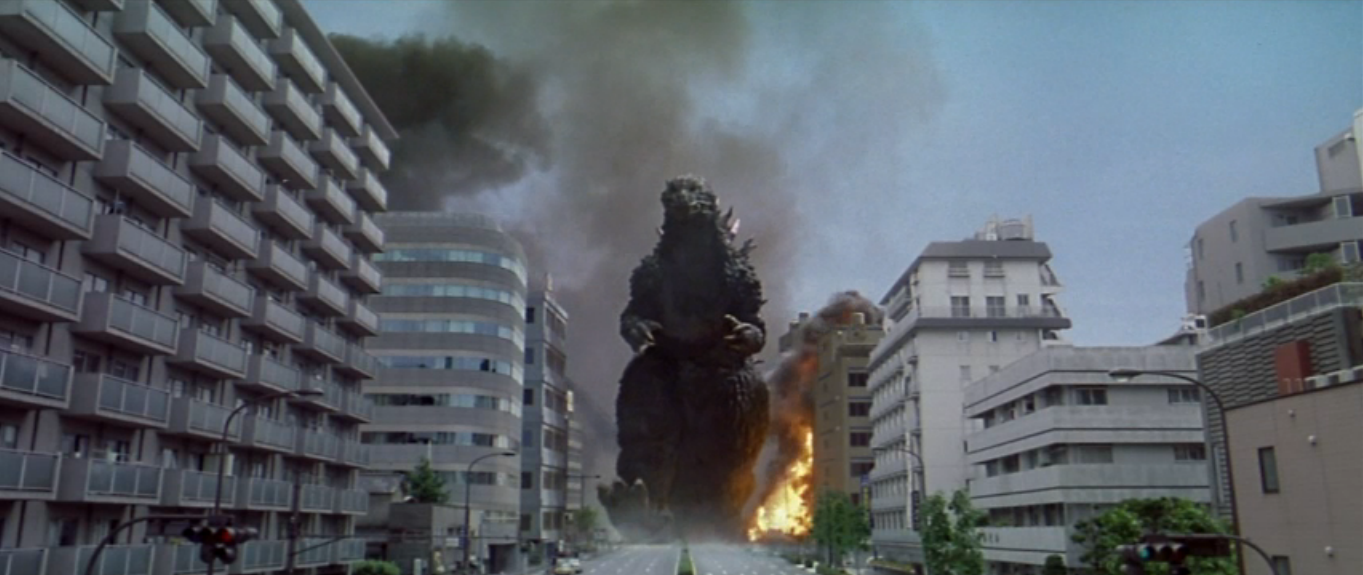

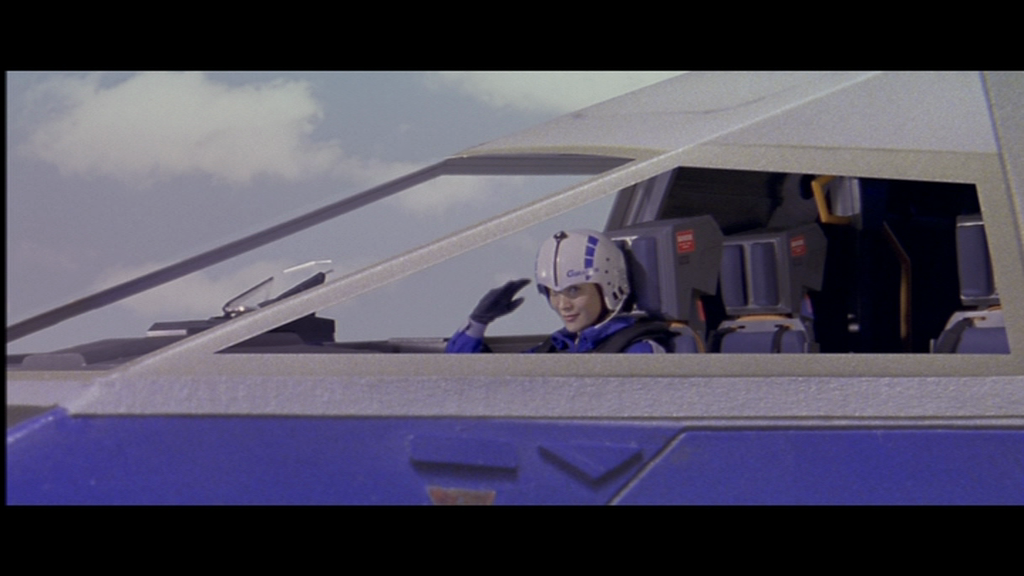 Megaguirus may be dead but the crisis is hardly over because Dimension Tide is starting to fall out of orbit, despite everyone's best efforts to get it under control. This dire situation, coupled with Godzilla resuming his attack on Tokyo, Tsujimori realizes that they're completely helpless to do anything to stop him. Godzilla tears through a building and begins walking straight down the street, leaving destruction and explosions in his wake. At HQ, Sugiura demands a chopper, saying that he's going to head out to the battle site himself. Yoshizawa then asks him what he's hiding from them but, again, Sugiura blows off her question and continues heading out. Yoshizawa decides to go with him and in the next cut, they're following Godzilla in the chopper as he continues down the street, heading for Shibuya. Hosono and Okumura finally manage to repair the Griffon and are able to take off, although they can't use their photon guns. They begin heading towards Godzilla, while back at headquarters, they discover that Dimension Tide is out of fuel and that it's not going to be able to hold its orbit for much longer. With the satellite now steadily falling towards the Earth, Yoshizawa and Sugiura land on a helipad in Shibuya and disembark to see Godzilla plow his way towards the science institute and begin smashing into the building. As he does so, the Griffon lands nearby and the three pilots disembark to join Yoshizawa and Sugiura. When Tsujimori asks why Godzilla is attacking the institute, Sugiura is forced to admit that they continued research into plasma energy and that there's a reactor. As he also admits that the research would ensure him a higher position in addition to much wealth for the entire country in the future, he's perplexed as to how Godzilla could sense the generator since it was temporarily shut down (that is a good question but it's never answered). That's when Tsujimori blames him for all of the people that have died and when he tries to turn it around on her and the G-Graspers, she decks him and has to be restrained by Yoshizawa to keep from attacking him further. As she watches Godzilla as he continues smashing into the institute, Tsujimori is contacted by Kudo, who tells her that he managed to get Dimension Tide's firing system up and running again but that they need to hurry because the satellite is continuing to fall out of orbit. Tsujimori then heads for the Griffon, while Dimension Tide begins to enter Earth's atmosphere, losing its panel-like wings in the process. They then say that they can't lock onto target but Tsujimori asks if the operating system is still working, which it is. She then says that she'll pilot the Griffon above Godzilla and that they can lock onto the ship to make it easier. Kudo tells her it's too dangerous but Tsujimori insists that it's what she's trained for and takes off.
Megaguirus may be dead but the crisis is hardly over because Dimension Tide is starting to fall out of orbit, despite everyone's best efforts to get it under control. This dire situation, coupled with Godzilla resuming his attack on Tokyo, Tsujimori realizes that they're completely helpless to do anything to stop him. Godzilla tears through a building and begins walking straight down the street, leaving destruction and explosions in his wake. At HQ, Sugiura demands a chopper, saying that he's going to head out to the battle site himself. Yoshizawa then asks him what he's hiding from them but, again, Sugiura blows off her question and continues heading out. Yoshizawa decides to go with him and in the next cut, they're following Godzilla in the chopper as he continues down the street, heading for Shibuya. Hosono and Okumura finally manage to repair the Griffon and are able to take off, although they can't use their photon guns. They begin heading towards Godzilla, while back at headquarters, they discover that Dimension Tide is out of fuel and that it's not going to be able to hold its orbit for much longer. With the satellite now steadily falling towards the Earth, Yoshizawa and Sugiura land on a helipad in Shibuya and disembark to see Godzilla plow his way towards the science institute and begin smashing into the building. As he does so, the Griffon lands nearby and the three pilots disembark to join Yoshizawa and Sugiura. When Tsujimori asks why Godzilla is attacking the institute, Sugiura is forced to admit that they continued research into plasma energy and that there's a reactor. As he also admits that the research would ensure him a higher position in addition to much wealth for the entire country in the future, he's perplexed as to how Godzilla could sense the generator since it was temporarily shut down (that is a good question but it's never answered). That's when Tsujimori blames him for all of the people that have died and when he tries to turn it around on her and the G-Graspers, she decks him and has to be restrained by Yoshizawa to keep from attacking him further. As she watches Godzilla as he continues smashing into the institute, Tsujimori is contacted by Kudo, who tells her that he managed to get Dimension Tide's firing system up and running again but that they need to hurry because the satellite is continuing to fall out of orbit. Tsujimori then heads for the Griffon, while Dimension Tide begins to enter Earth's atmosphere, losing its panel-like wings in the process. They then say that they can't lock onto target but Tsujimori asks if the operating system is still working, which it is. She then says that she'll pilot the Griffon above Godzilla and that they can lock onto the ship to make it easier. Kudo tells her it's too dangerous but Tsujimori insists that it's what she's trained for and takes off.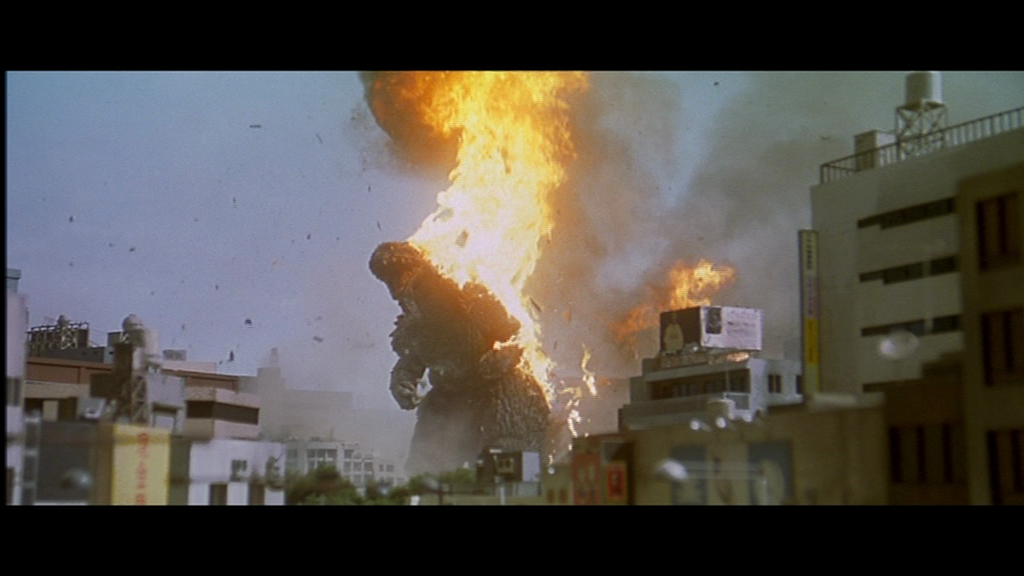
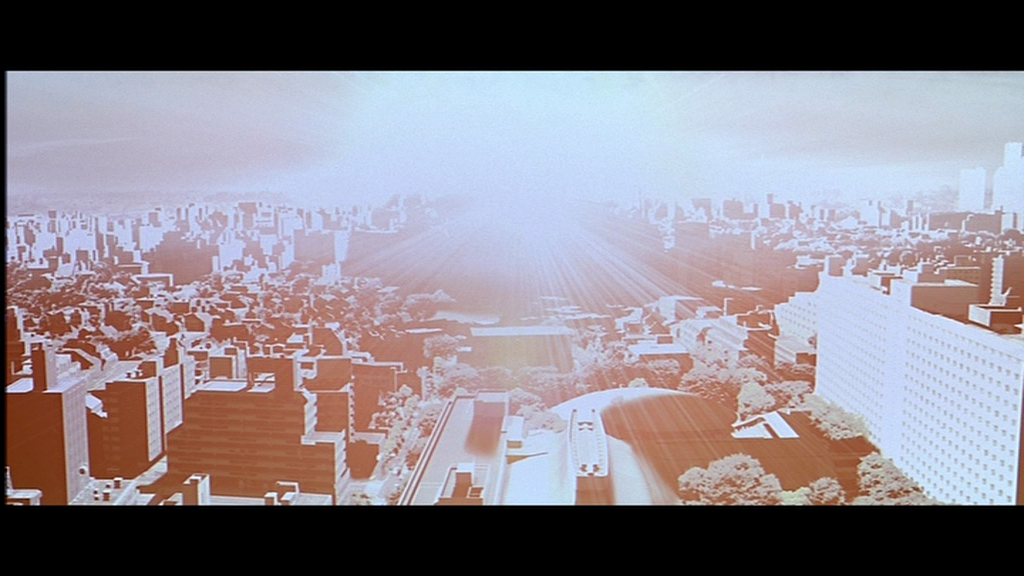
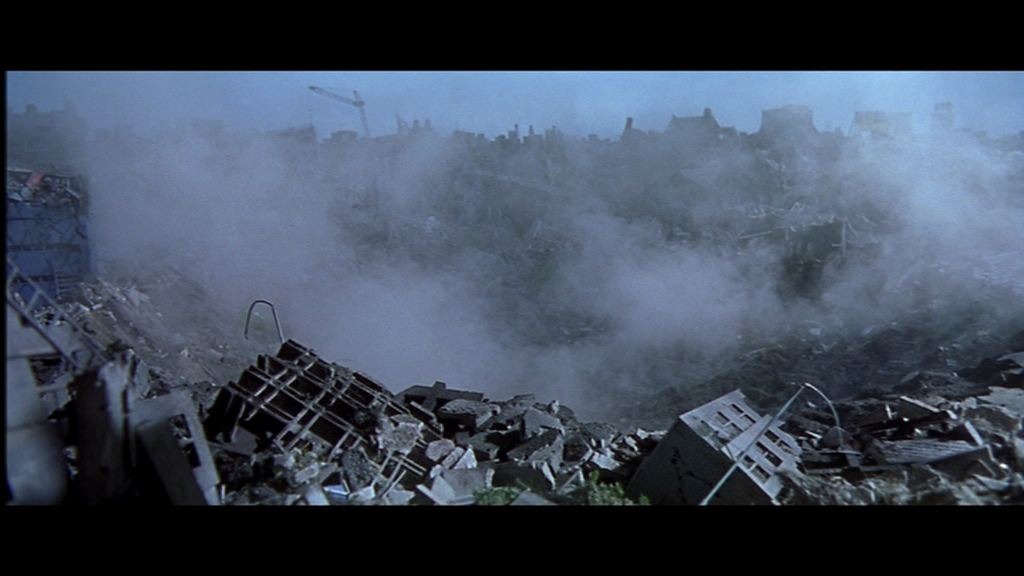 Flying out directly above Godzilla, Tsujimori is told that there are only 150 seconds left on Dimension Tide's countdown but she says that should be enough. As the satellite continues to disintegrate as it falls through the atmosphere, Tsujimori manages to get the Griffon in place and they're able to get a lock-on. While she waits for the final hour, Tsujimori takes out Miyagawa's dog-tags and places them on the control panel, giving them a salute. She then swoops around and heads straight down, aiming the craft at Godzilla. With one minute left to go, and Dimension Tide beginning to melt down, with only the bare minimum of the device remaining, Tsujimori closes in on Godzilla and tells those at HQ that it's time. Kudo volunteers to press the button when she gives the fire command and when it happens, the black hole is fired out of Dimension Tide right before it explodes in the atmosphere. Tsujimori then ejects out of the Griffon, which crashes into Godzilla's back and sets his spines ablaze. He shakes off the impact but then looks up to see the black hole appear in the sky above him. As it comes straight at him and begins sucking everything up, Godzilla attempts to destroy it with his atomic blast but it absorbs that like everything else and eventually reaches him, completely engulfing him and everything around him. A massive, bright flash of energy appears across the skyline and then quickly dissipates, leaving an enormous crater behind. Tsujimori manages to land with her parachute in a swimming pool and when Kudo gets in touch with her as she climbs out, he tells her that Godzilla is gone, that it looks like Dimension Tide worked. Everyone at HQ then erupts in cheers upon having apparently won, while out in the city, Tsujimori watches the sun set and looks at the crater left behind by Dimension Tide, confident that they've won. The film actually has two endings: the first happens right before the end credits, with Kudo back in Osaka some time later (not too long, though, since his arm is still badly injured) when he's visited by Tsujimori and Okumura, who tell him that they've received a report of some seismic activity. She then ponders if Godzilla somehow escaped the black hole and asks Kudo to help them in finding out. Kudo at first refuses but then reveals that he's joking. It then ends like a sitcom, with Tsujimori giving Kudo a friendly shove on the arm with her elbow, Kudo complaining that his arm still hurts, and Tsujimori apologizing as the image of her face freezes. A small epilogue follows the credits (as is the case with a couple of more films down the line) where we see the little boy Jun now living somewhere else. He's at school and takes some insect samples to the lab there when the place suddenly begins shaking like an earthquake. The film ends for real with a freeze on his terrified face when he runs to the window to see what's going on and we hear Godzilla roar, confirming that he did indeed survive the black hole (I'd like to know how he pulled that off, though, wouldn't you?)
Flying out directly above Godzilla, Tsujimori is told that there are only 150 seconds left on Dimension Tide's countdown but she says that should be enough. As the satellite continues to disintegrate as it falls through the atmosphere, Tsujimori manages to get the Griffon in place and they're able to get a lock-on. While she waits for the final hour, Tsujimori takes out Miyagawa's dog-tags and places them on the control panel, giving them a salute. She then swoops around and heads straight down, aiming the craft at Godzilla. With one minute left to go, and Dimension Tide beginning to melt down, with only the bare minimum of the device remaining, Tsujimori closes in on Godzilla and tells those at HQ that it's time. Kudo volunteers to press the button when she gives the fire command and when it happens, the black hole is fired out of Dimension Tide right before it explodes in the atmosphere. Tsujimori then ejects out of the Griffon, which crashes into Godzilla's back and sets his spines ablaze. He shakes off the impact but then looks up to see the black hole appear in the sky above him. As it comes straight at him and begins sucking everything up, Godzilla attempts to destroy it with his atomic blast but it absorbs that like everything else and eventually reaches him, completely engulfing him and everything around him. A massive, bright flash of energy appears across the skyline and then quickly dissipates, leaving an enormous crater behind. Tsujimori manages to land with her parachute in a swimming pool and when Kudo gets in touch with her as she climbs out, he tells her that Godzilla is gone, that it looks like Dimension Tide worked. Everyone at HQ then erupts in cheers upon having apparently won, while out in the city, Tsujimori watches the sun set and looks at the crater left behind by Dimension Tide, confident that they've won. The film actually has two endings: the first happens right before the end credits, with Kudo back in Osaka some time later (not too long, though, since his arm is still badly injured) when he's visited by Tsujimori and Okumura, who tell him that they've received a report of some seismic activity. She then ponders if Godzilla somehow escaped the black hole and asks Kudo to help them in finding out. Kudo at first refuses but then reveals that he's joking. It then ends like a sitcom, with Tsujimori giving Kudo a friendly shove on the arm with her elbow, Kudo complaining that his arm still hurts, and Tsujimori apologizing as the image of her face freezes. A small epilogue follows the credits (as is the case with a couple of more films down the line) where we see the little boy Jun now living somewhere else. He's at school and takes some insect samples to the lab there when the place suddenly begins shaking like an earthquake. The film ends for real with a freeze on his terrified face when he runs to the window to see what's going on and we hear Godzilla roar, confirming that he did indeed survive the black hole (I'd like to know how he pulled that off, though, wouldn't you?)Michiru Oshima, a veteran composer of film, video games, and anime, is the first female composer to score a Godzilla movie and her music in this film is, for the most part, good but not exactly iconic or memorable. Like Takayuki Hattori in the previous film, Oshima does make use of the iconic Godzilla theme but she also creates a new theme for the Big G that she uses much more often. It's a piece that gradually builds with some ominous banging sounds and low horns before ultimately swelling into a sweeping and very strong main symphony. It's by far the most memorable theme in the film's score and it is good music but I think Oshima really overuses it, to the point where you can easily get tired of it. She should have tried to mix it up and put the original theme in a few more spots rather than only playing twice in the entire film. But then again, when she came back to score both Godzilla Against Mechagodzilla and Godzilla: Tokyo S.O.S. down the road, she would make this Godzilla's only theme, so I guess you'd better enjoy the classic one here while you can. Her theme for Megaguirus and the other insect monsters is a frantic, string-heavy piece that she apparently based on Alfred Hitchcock's The Birds (although, when she says that the strings are meant to mimic a bird's screeching cry, it's quite possible she's actually getting it mixed up with the complete string-oriented score for Psycho rather than The Birds, which has no music at all). It's a good piece of music that fits well with the chaos and swarming effect of the Meganulas and the crazy destruction wrought by Megaguirus but, again, it's not something you'll remember a few days after hearing it. In fact, I like another action piece that you hear during Godzilla's skirmish with the Meganula swarm and when Megaguirus makes her first appearance much more. That's some very memorable, cool, pounding music right there. There's another, ominous-sounding theme in the scenes that have to do with the Meganula egg that Jun finds that not only works fairly well but actually reminds me of the opening bit of music that Graeme Revell composed for Bride of Chucky (kind of appropriate given the slasher movie vibe you get during those scenes with the Meganulon stalking and killing people). The rest of the music, like the big, grand theme for Dimension Tide that you hear every single time it's mentioned or put into the action, the other action pieces, and the music for the solemn and comedic moments are pretty generic, for the most part. Overall, not a great score, and it does have some problems with repetition, but it's certainly not a bad one either.
 Sony had originally intended to put Godzilla vs. Megaguirus and the next film, Godzilla, Mothra and King Ghidorah: Giant Monsters All-Out Attack, into American theaters but that plan was scrapped when Godzilla 2000 didn't exactly light the U.S. box-office on fire (it's probably a good thing that didn't come to pass because this movie would have fared even worse with cynical, modern-day American audiences due to its really bad, cheap effects work). With that matter settled, they went back to simply acquiring the rights to the Toho "international" dubs of each film and bringing them straight to DVD. They actually premiered both this film and the next one on Sci-Fi Channel before putting them out on DVD. As for the home media release of this film, aside from the aforementioned overly bright print that Sony used that ended up revealing even more flaws in the effects work, especially with the Megaguirus model, the dubbing is about what you've come to expect with these recent films. It's on par with the best dubbing used for the Heisei series: not the greatest in terms of emotion, performance, or lip synch, and some of the voices don't feel like they match the person they're attached to (the one for Kudo sounds too old to be coming from someone that young and the voices given to some of the kids are, as expected, really bad) but, on the whole, it's not absolutely painful to listen to like other dubs. Plus, if you're nostalgic for the Heisei dubs, some of those voices can be heard again here, including the guy who dubbed Commander Aso as the newsreel narrator at the very beginning of the movie. However, I don't care for the way these international versions handle the titles, which is by keeping the original effects used when the titles first come up but plastering an English translation of it over it, keeping you from seeing what's going on clearly. For instance, here they have some effects where Megaguirus' name in kanji comes zipping around Godzilla's and plants itself beneath it, with more symbols being shot across the section beneath both of them, but the stupid English title keeps you from seeing it clearly, which is really irritating. The company that created these dubs did that with the Heisei films as well but then, Sony was good enough to tweak it and put the English title beneath the Japanese one for each film, although they created their opening credits and removed the ending ones, which they don't do with the Millennium films. It's nitpicky, sure, but I still do wish they had taken the same approach with the films' actual titles that they had done with the Heisei films.
Sony had originally intended to put Godzilla vs. Megaguirus and the next film, Godzilla, Mothra and King Ghidorah: Giant Monsters All-Out Attack, into American theaters but that plan was scrapped when Godzilla 2000 didn't exactly light the U.S. box-office on fire (it's probably a good thing that didn't come to pass because this movie would have fared even worse with cynical, modern-day American audiences due to its really bad, cheap effects work). With that matter settled, they went back to simply acquiring the rights to the Toho "international" dubs of each film and bringing them straight to DVD. They actually premiered both this film and the next one on Sci-Fi Channel before putting them out on DVD. As for the home media release of this film, aside from the aforementioned overly bright print that Sony used that ended up revealing even more flaws in the effects work, especially with the Megaguirus model, the dubbing is about what you've come to expect with these recent films. It's on par with the best dubbing used for the Heisei series: not the greatest in terms of emotion, performance, or lip synch, and some of the voices don't feel like they match the person they're attached to (the one for Kudo sounds too old to be coming from someone that young and the voices given to some of the kids are, as expected, really bad) but, on the whole, it's not absolutely painful to listen to like other dubs. Plus, if you're nostalgic for the Heisei dubs, some of those voices can be heard again here, including the guy who dubbed Commander Aso as the newsreel narrator at the very beginning of the movie. However, I don't care for the way these international versions handle the titles, which is by keeping the original effects used when the titles first come up but plastering an English translation of it over it, keeping you from seeing what's going on clearly. For instance, here they have some effects where Megaguirus' name in kanji comes zipping around Godzilla's and plants itself beneath it, with more symbols being shot across the section beneath both of them, but the stupid English title keeps you from seeing it clearly, which is really irritating. The company that created these dubs did that with the Heisei films as well but then, Sony was good enough to tweak it and put the English title beneath the Japanese one for each film, although they created their opening credits and removed the ending ones, which they don't do with the Millennium films. It's nitpicky, sure, but I still do wish they had taken the same approach with the films' actual titles that they had done with the Heisei films.